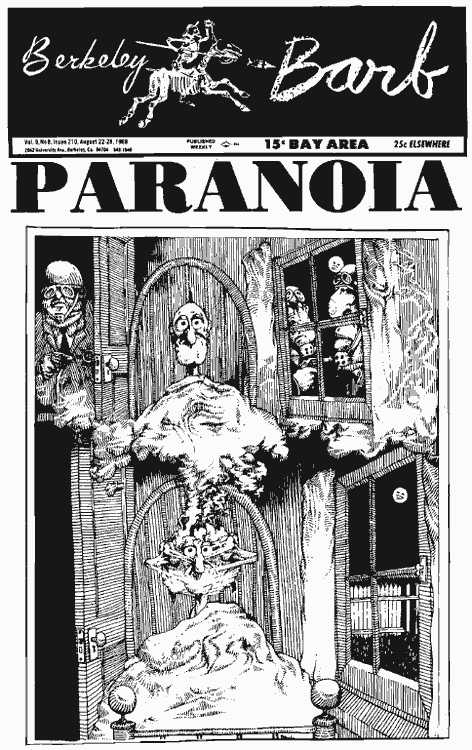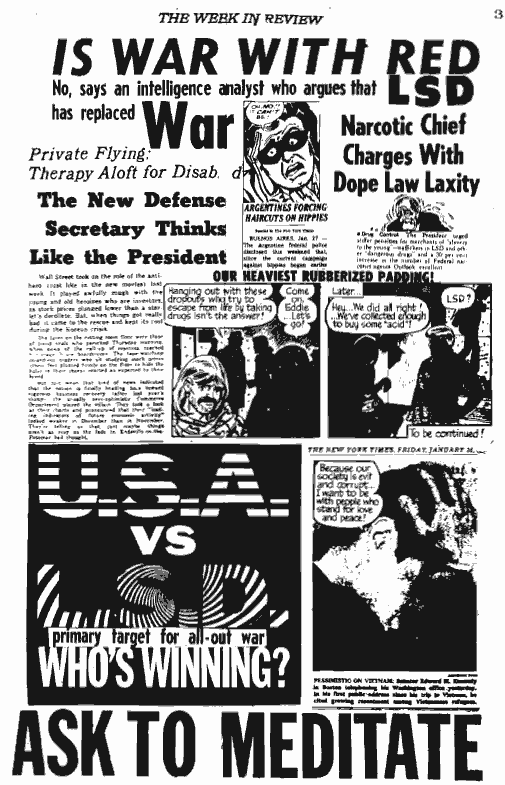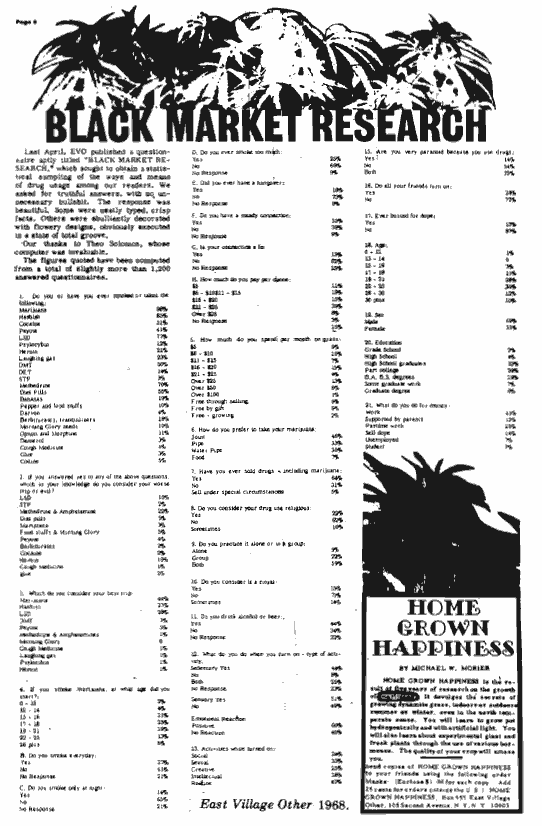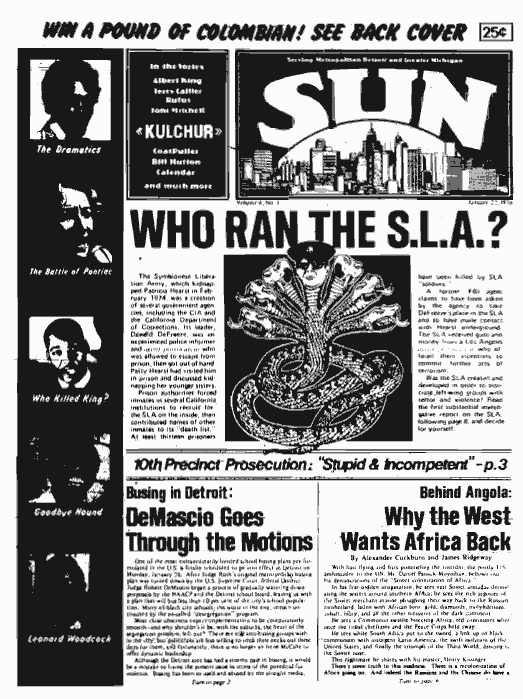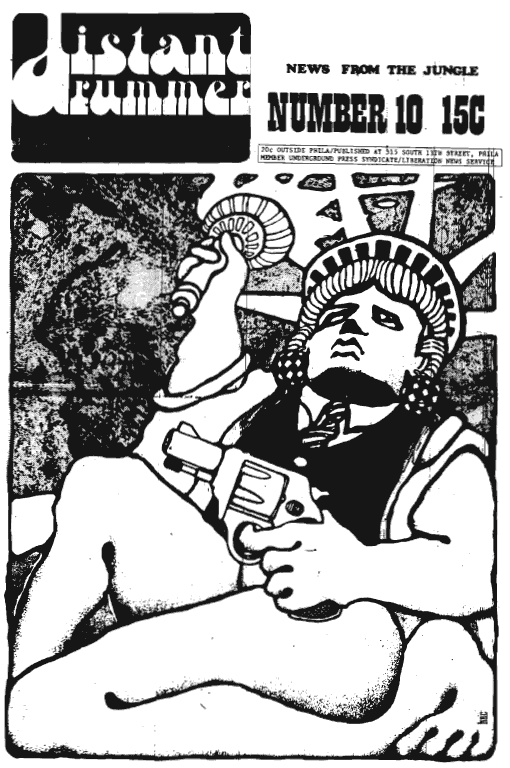NOTE
In the mid-1970s, Allen Ginsberg, a member of PEN American Center's Freedom to Write Committee, suggested that it look into rampant government sabotage of the underground press movement. Most of PEN's 1500 members were aware of intelligence agency abuses but not of their extent. Because the Freedom to Write Committee works on behalf of imprisoned writers and censored writing around the world, it agreed to investigate if Ginsberg 'would provide the evidence he had amassed. Between 1968 and 1972, he had been collecting newspaper clippings, letters, and sworn affidavits from those who had been harassed, as well as files obtained through the Freedom of Information Act. People sent him reports of incidents, which they sometimes regarded as curious, sometimes as sinister; however, when assembled, they formed a pattern of systematic abuse. Ginsberg put this information at the disposal of the Freedom to Write Committee, which asked me, in 1979, to gather more information and write this report.
I would like to thank many people for their assistance: Allen Ginsberg; Dore Ashton and the Freedom to Write Committee; Karen Kennerly, PEN Executive Director; Bob Rosenthal; Ira Lowe; Jerry Simon Chasen; Marty Lee of the Assassination Information Bureau; Craig Silver of the Alternative Media Syndicate; the Fund for Open Information and Accountability, Inc.; Michael Ratner of the Center for Constitutional Rights; the Center for National Security Studies; the Campaign for Political Rights; Chip Berlet; Ms. magazine; Lucien Carr; Ellen Binder; Nancy Maniscalco; and Nancy J. Peters and Anne Janowitz of City Lights.
This book is dedicated to writing judged unfit to print in The New York Times. It is dedicated to the anarchic, rawboned prose of investigative reporters not content with the information in press releases, to those journals so economically vulnerable that they were supported by their workers. It is dedicated to the writers, editors, artists, designers, distributors, and sellers, who worked day and night on antiquated, broken-down equipment, who wondered if the phones were tapped and why the mail never arrived, whose cameras were smashed, who went to jail.
This book is dedicated to the memory of William B. Schanen, courageous printer and publisher, to the memory of D. A. Levy, poet and editor of The Buddhist Junkmail Oracle, to the memory of George Jackson, to the memory of Tom Forcade, to the memory of Daniel DesRoches.
This book is written for the sounding of the "barbaric yawp over the roofs of the world."
—Geoffrey Rips
DISSIDENT VOICES
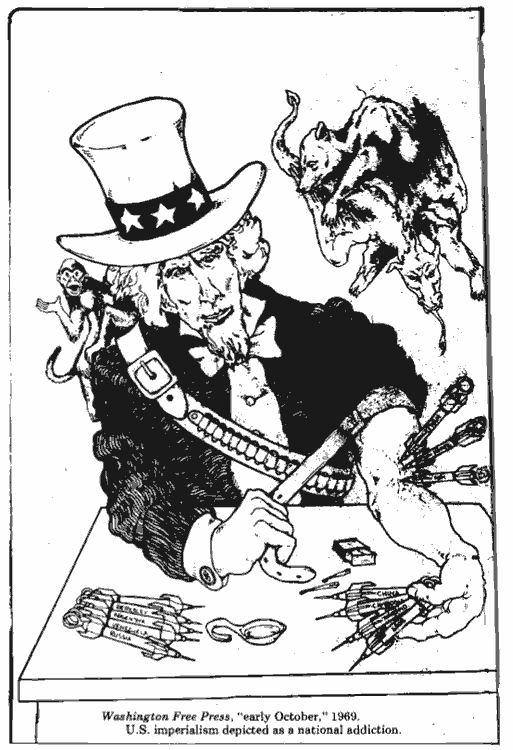
Washington Free Press, "early October," 1969
Surprisingly, the rapid growth in the number of underground newspapers and readership was mirrored by a sudden, equally rapid, decline in the early 1970s. The fate of the underground press followed that of the Movement, in general. The end of that great incubator of dissent, the Vietnam War, and the dismantling of the draft reduced the sense of immediacy felt by many people. Disagreements over strategy and goals fragmented the nascent New Left. While alternative journals belonging to the older traditions of muckraking, Left political commentary and party papers survived into the 1980s, the self-supporting, community-based underground press began to lose the vast number of readers it had once attracted. Many papers simply couldn't make it financially in the increasingly apathetic 1970s. Others were gradually taken over by commercial interests, which, having discovered a new market for records, drug paraphernalia, and fashions, thrived on advertising revenues and diluted political content.
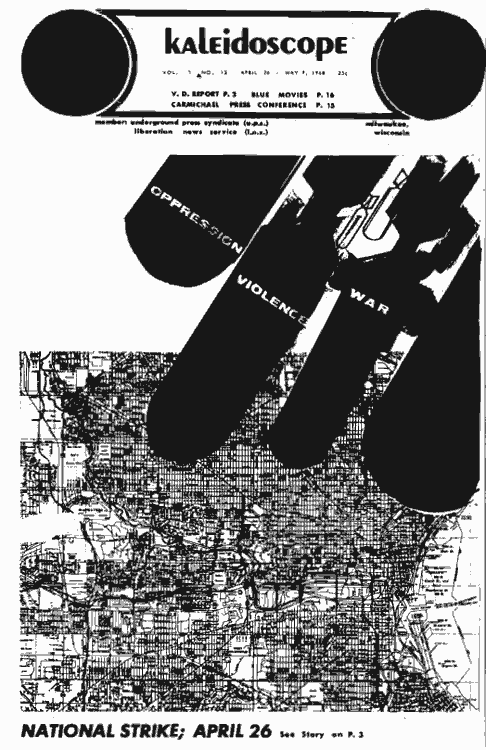
Kaleidoscope, April 26-May 9, 1969
The freedom of expression and the freedom of the press have always been relative freedoms. A government intent on controlling the economic and social realities of a country must understandably become involved in the manipulation of the written perception of those realities, even at the expense of legal and moral principles held to be the cornerstone of that government. Dissenters from the British Crown founded this country and wrote into its Constitution provisions to ensure free discussion of the public good. The First Amendment is explicit: "Congress shall make no law ... abridging the freedom of speech or of the press." This is a liberty heralded as a model for the rest of the world. Although it is not customary to associate the American experience with police and military action against writers, our press liberties have always been in jeopardy. Government surveillance of political and cultural expression has existed here not only for decades but for centuries. The re-affirmation of these freedoms by one generation seems to be either taken for granted or forgotten by the next. The suppression of press freedom during the McCarthy era was not an aberration of the 1950s as some recent films and articles suggest.
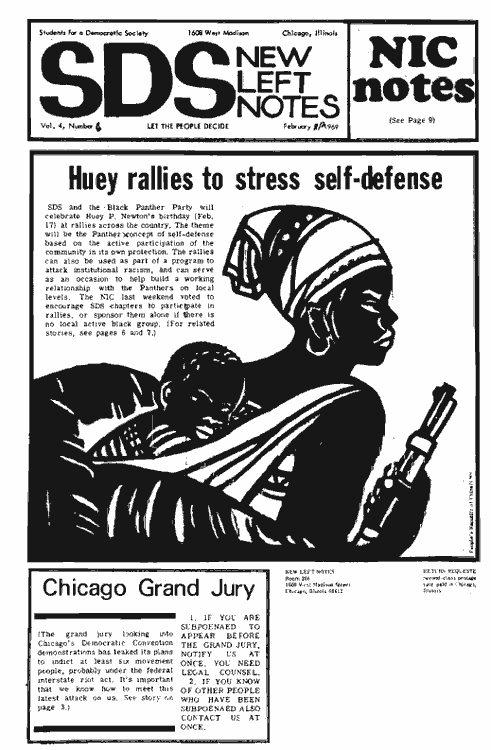
SDS/New Left Notes, February 12, 1969
In the past twenty years, the consolidation of domestic and international intelligence networks, the increasing feudal power of the multinational corporations, and the predominance of recording tape, the computer, and the silicon chip have brought a new sophistication to the control of the written word. Because the silicon chip can store vast quantities of information, printed matter can be scanned and analyzed for "sedition" with great speed and little labor. A more subtle kind of control takes place too. With the sheer mass of information available to media, censorship has come to operate by simply excluding what is aberrant. The marginal economic nature of underground newspapers and the "marginal news" they carried—often considered not "fit to print" by established dailies—rendered them particularly vulnerable to government persecution because they were considered outside the limits of polite society and, therefore, not worthy of the constitutional guarantees afforded established writers and publications.
Whether or not they were affiliated with specific political formations, people drawn to underground papers were activists against the war in Southeast Asia, and many also worked with programs for social reforms, or on behalf of oppressed groups such as women, blacks, or gays. The government was first alerted to the political implications of the underground press movement through its surveillance of maverick cultural and political movements. Its interest in underground writing intensified when a nation-wide network of alternative media began speaking to and for a largely youthful counterculture that troubled those in power by raising urgent issues untouched by the commercial media.
Small journals began springing up all over the country. They had much in common: they opposed the Vietnam war, advocated sexual and artistic freedoms, and urged critical o consciousness towards conventional authority and power relations. Some called for communal or cooperative living; and many warned of the dangers of uncontrolled technology, especially nuclear power. Poetry, prose, graphic arts, and coverage of folk and rock music thrived in the underground. And these popular arts swelled the rising tides of dissent.
Political information supplied by independent news services, such as the Liberation News Service and the Underground Press Syndicate, usually differed greatly from that offered by establishment media, which often relied heavily on government and Pentagon sources. Just as alarming to Washington may have been the close connections between alternative media and independent community action. Many of the underground papers worked closely with daycare centers, free medical clinics and food cooperatives. Others were connected with movements to extend social democracy and with insurgent political parties. The Black Panther Party, for example, initiated school breakfast and neighborhood defense programs. These and other issues vital to blacks were discussed in its Black Panther Party Paper. Members of the White Panther Party of Detroit worked on the staff of the Fifth Estate. Both the independent newspapers and organs of political parties encouraged a relationship between reader and publisher that challenged the one-way transmission of news and information characteristic of the establishment press. Most staff members worked on a volunteer basis, and financially supported the papers, rather than the other way around, proving how vital publication was to the growing counterculture and how closely readers and newspapers could cooperate to meet social needs. These connections between expression and action looked dangerous to those who feared changes in the status quo. Community participation bent on alternative ways of doing things provoked suspicion. The government perceived in these grass roots relationships "anti-social" threats.
The new journalism, it seemed, was partly responsible for the increased political power of the hippies, New Left and anti-war movements. The government move against the underground press was clearly intended to blunt a potential force for political and social change. Official police agencies, however, rarely admitted they were prosecuting alternative papers for their political positions, but alleged that press offices were used as meeting places to plan illegal, even terrorist activities. They hunted for marijuana, arrested editors for obscenity, and quibbled over street vending rights.
At the same time, most underground journals regarded the publication of erotic art, four-letter words, and discussions about drugs and alternative living to be acts of cultural enlightenment. They viewed arrests for drug violations, distribution of "pornographic" literature, and unlicensed vending as political arrests while government agencies worked to dissociate these forms of harassment from any notion of political repression. In fact, the government rarely attempted to prosecute any underground newspaper for its open political statements and never obtained a conviction on a political charge. Often the real issues of freedom of the press never came to light. Faced with the prospect of trials on petty charges, and unable to meet court costs, underground papers were ruined. Fourth Amendment rights were violated in searches and seizures of equipment by police agents. Records were lost, typewriters destroyed, and staffs disbanded as a result of police raids. When they failed to find drugs, agents nevertheless ransacked equipment and files. In other cases, where drugs were found, police brought publication to a halt by arresting an entire staff rather than charging an individual offender.
Neither the severity nor the scope of this outrageous campaign of harassment against alternative media was reported by major American news organizations. Equating partisanship with a failure to tell the truth, most establishment journalists did not see, in the move against vanguard and counterculture presses, a more general threat to constitutional guarantees of free expression and seldom looked behind the scenes to investigate harassment as a deliberate attempt to silence an adversary voice. There was no eagerness to cover an underground press that often vociferously criticized establishment media.
Most of the time, government interference with underground writing was reported in an uncoordinated and local manner. The sudden refusal of a printer to continue printing a paper1, an overnight doubling of a journal's office rent,2 advertising cancellations,3 or shipping losses4 fostered a not unjustified suspicion of large-scale interference by government agencies. Officials dismissed such complaints as "paranoid." Given the bizarre nature of some of these cases, established media and even some sectors of the underground were inclined to agree.
The frequent failures of alternative newspapers and the many arrests of staff members were greeted in some quarters as an indication of the tenuous, "off the wall," and irresponsible nature of underground journalism. The failures and arrests bred an insecurity among staff members that itself contributed to the failure of several publications.
Now, however, the facts unearthed in the late 1970s by Congressional hearings, and documents the FBI was forced to release to those it spied on, tell a different story. They reveal how extensively government interference contributed to the failure of underground papers. When young people were politicized, when writers and intellectuals came out against the war, and when alternative journalism began to have political clout, intelligence agencies responded with a comprehensive program to put the lid on free expression. This meant surveillance, illegal covert action, intimidation, and harassment at federal, state, and local levels.
This report collates evidence gathered from defunct alternative publications and from those that survived despite continuing persecution. Important corroboration comes from Senate and House hearings on the U.8. intelligence agencies and from information made available through the Freedom of Information Act. It is the nature of the bureaucratic beast that its agencies' crimes often lie hidden for years, only made public years later, when it is politically expedient to do so. The events outlined in this report are not simply a matter of history— they are a warning for the future of free expression in this country.
The Network of Suppression
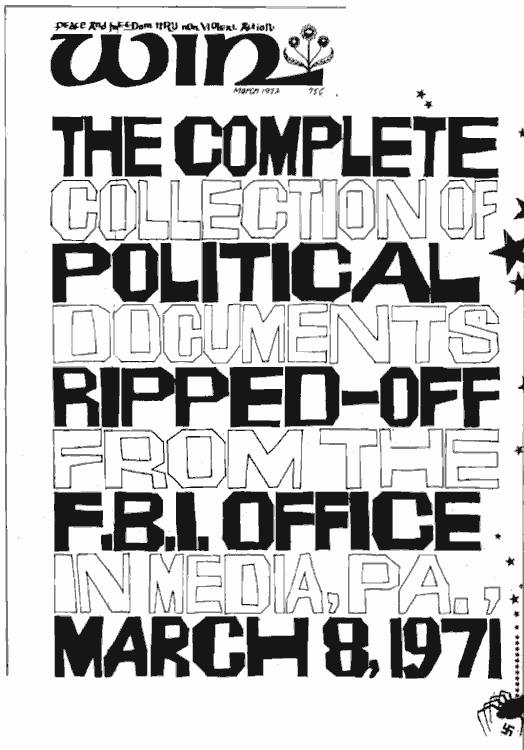
WIN, March, 1972.
Although theoretically answerable to an elected authority, these agencies acted with relative autonomy. Because intelligence bureaucracies outlive presidential administrations, each agency is able to perpetuate itself by maintaining a cloud of secrecy around its operations to keep "outsiders" from full knowledge or control of its maneuvers.
Spying Together
Every presidential administration, however, did try to control intelligence and law enforcement agencies through directives, suggestions, appointments, and, when police agents got out of hand, by censure. In the mid 1960s, Lyndon Johnson tried to engineer a coordinated system of investigation. After an administrative meeting on urban riots, the Federal Bureau of Investigation set up a Security Index and a Rabble Rouser Index.5 Under Richard Nixon, these lists were expanded and made available to all federal agencies. In 1967, responding to pressure from the Johnson administration, the CIA and the National Security Agency joined forces in an enlarged domestic intelligence program to ferret out "foreign influences" on domestic unrest. Along with the FBI and CIA, the National Security Agency put together a "Watch List" of dissident Americans.6 The Nixon administration profited from advances in technology and put computers and electronic tapes to work in the most powerful and extensive intelligence network ever seen in America.
While centralized intelligence information required cooperation among intelligence and law enforcement agencies, each agency fashioned its own program of domestic surveillance and grew inflated with ever bigger operations.
In 1970, the Nixon administration created the Interagency Committee on Intelligence, made up of the directors of the CIA, NSA, FBI, and the Defense Intelligence Agency. From its machinations, presidential advisor Tom Huston prepared the notorious Huston Plan—a domestic and foreign intelligence program to be controlled by the President. This plan called for opening mail, electronic surveillance, monitoring communications, break-ins, and campus infiltration.7 It was partially implemented, bringing a new cohesiveness to Federal agencies. It did not prevent various agencies from acting on theirown. For example, the National Security Agency had been monitoring domestic communications and the CIA had been opening citizens' mail for years without letting either the FBI or the Nixon administration know what they were doing.8
In fact, each agency cooperated with the President and police agencies only when that cooperation served its own interests. Usually, this meant expansion and intensification of that agency's authority. While the CIA and NSA were extending domestic surveillance, military intelligence began to monitor civilians as well as military personnel. At this time, the IRS used its tax intelligence division as a political weapon. The common link in this new net of spyingwas the local police, working with these federal agencies to increase their own power. Far from being a single, well-coordinated and planned offensive, then, the campaign against the underground press was executed by separate, often competing agencies. State and local law enforcement intelligence divisions, acting on their own initiative, launched investigations. While regional police often worked in tandem with federal agencies or through the Law Enforcement Intelligence Union (LEIU), they also paid attention to local political pressures. In monitoring and controlling underground writing, each police agency used its own strategy.
You're In The Army Now
In 1971, after Congress held hearings on domestic intelligence, the military was pressured to reduce its surveillance of civilians. The Department of Defense established a Defense Investigative Review Council (DIRC) to oversee military intelligence plans that targeted civilian groups. However, the DIRC approved many surveillance operations, including spying on a California underground newspaper, in 1971-1972.10
Because military intelligence maintained close ties with the FBI, it often acted as the FBI liaison abroad, insinuating agents into United States civilian and military groups. Between 1972 and 1975, Army and Navy intelligence closely monitored and attempted to infiltrate staffs of underground newspapers published by United States citizens in Japan and West Germany.ll Among others were Fight Back, published in Heidelberg, and Forward, in West Berlin.
During the last twenty years, military intelligence has played an ominous role in the affairs of civilian writers at home as well. On January 14, 1969, Army intelligence took part in an FBI search of the offices of the Free Press, a Washington, D.C., underground newspaper. The Army agents kept the documents they found in the search. Throughout the 1960s, Army intelligence and the Chicago Police Department regularly exchanged intelligence information. When restrictions placed on military intelligence in 1971 called for destroying files on civilians, Army agents in Chicago, Cleveland, Pennsylvania, and Washington, D.C., gave the files instead to local and state police.12
COINTELPRO: The "Moral Minority"
The FBI worked well with military intelligence. They shared a highly authoritarian internal structure, and, during the 1960s, saw themselves as defenders of a rigorously structured society against the incursion of subversive elements.13 The FBI, under J. Edgar Hoover, was an immensely powerful bureaucracy that made a public virtue of its secrecy. Until Hoover's death it was virtually free from Congressional oversight or executive review. In addition to implementing presidential initiatives, its independence enabled it to wield great power in the determination of policy.
In 1956, in the wake of the McCarthy era, the FBI initiated its vast counterintelligence program (COINTELPRO) "to disrupt, expose, discredit, and otherwise neutralize the United States Communist Party and related organizations."14 Although the FBI had worked closely with other elements in the federal government in carrying out the witch hunts of the early 1950s, the subsequent discrediting and censure of McCarthy's activities made Hoover see the FBI as the last bastion in the war against "communist subversion" of the government. The Bureau surrounded its COINTELPRO operations with such secrecy that no President or advisorwas ever aware of its entire scope.
Under COINTELPRO, the FBI planted stories about "subversives" in the media, wrote scurrilous letters from fictional sources, opened mail, forged public documents, pressured universities and employers to dismiss targeted workers, encouraged "friendly" organizations and local police to harass dissidents, exploited IRS tax records, and infiltrated legal organizations. Expanding well beyond harassment of Communist Party members, the FBI operation soon included any group with a left, socialist, pacifist, or minority rights position the agency arbitrarily judged "subversive."15
The FBI viewed underground writing in the 1960s and 1970s as one part of a concentrated political movement threatening the security of this country. The authority of COINTELPRO expanded to include the monitoring of putative "foreign infiltration" of newly-formed domestic political movements. No proof ever appeared that the underground press was under foreign influence, and the Church Report found that the FBI failed to provide a shred of evidence of it. As in so many other cases, this "infiltration" proved to be pure fiction. In fact, much of the vigor of the U.S. underground press arose from its indigenous spontaneity and cantankerous nature. At the same time, the FBI was able to exploit this rather uncoordinated obstreperousness for its own ends.
COINTELPRO was directed against New Left, anti-war and women's groups, Black Liberation and civil rights organizations, as well as individuals such as Martin Luther King, Jr. The way was opened for a full-scale FBI program against constitutionally guaranteed rights of free speech. The FBI interpreted a Presidential instruction from the 1950s as a mandate to disrupt by any means all political activity not in agreement with current official policy. Lists of "subversives" were drawn up, along with new definitions of threats to national security. This led the agency to participate in illegal break-ins as well as to create a new monitoring bureau - the Interdivisional Information Unity (lDIU)16, a data bank of all information collected by a number of agencies.
THIS IS YOUR FBI
On November 5, 1968, the day Richard Nixon was elected president, J. Edgar Hoover sent to FBI offices around the country a memo zeroing in on "New Left Movement Publications." He requested an immediate "detailed survey concerning New Left-type publications being printed and circulated in your territory on a regular basis." He additionally asked for information on each paper's publisher, printer, sources of funds, identity of editorial staff, subversive connections, and possible foreign ramifications.
FBI memoranda of 10/11/68 and 1/17/79 document the Bureau's creation of two mock underground publications, Armageddon News in Indiana and Longhorn Tales in Texas, to promote the view that most students were not participating in protest movements.18 The FBI believed that one of its best weapons against the New Left was the "shocking" writing and art in underground publications. The agency found ideas about sexual and political liberation in these journals to be decadent and depraved. The moral indignation the Bureau expressed in COINTELPRO memoranda was used to rationalize and exercise unmandated powers against independent publications. The older crusade against "Communist" influence became a crusade against the emerging counterculture. The campaign against alien subversion became a campaign against dissent and alternative strategies for living.
CIA: POLITICAL ILLEGALITY: OPERATION CHAOS
The Central Intelligence Agency, on the other hand, did not rely on a moralistic position to justify action against underground writing and the counterculture. Instead it saw itself as a highly professional agency whose purpose was to carry out, overtly and covertly, the wishes of the executive branch. Yet CIA agents soon took on powers that were often illegal and unknown to those they served. The CIA's domestic mail-opening program, which ran from 1952 through 1973, was hidden from Presidents Truman, Eisenhower, Kennedy, and possibly Johnson. So secret were these machinations that not only was the Postmaster General kept in the dark, but even CIA directors John McCone and Admiral William F. Raborn, Jr. claimed ignorance.19
While the CIA had originally been created for foreign intelligence operations, it became more and more occupied with dissident activity at home. The Counter-Intelligence Division of the CIA initiated Operation Chaos at the behest of the Johnson administration in 1967 to determine foreign influence on antiwar groups.20 The CIA interpreted this request as a license to conduct illegal surveillance and disruption.
In general CIA agents had a more liberal outlook than those in the FBI. This was particularly true in the early years when the agency was evolving out of the World War II Office of Strategic Services (OSS). Even though the"dirty tricks" of the Counter-Intelligence branch began to dominate operations, the agency still regarded its effort as a skilled professional campaign against a political enemy in which questions of public morals or legality were irrelevant. Thus it did not, like the FBI, become histrionic over sex and drugs in the underground. The CIA's public rationale was that the counterculture and its publications were giving comfort and support to the North Vietnamese and the Viet Cong, and that, therefore, its actions against them were a domestic front in the Vietnam war effort.
A substantial percentage of CIA recruits came from patrician families, graduated from Ivy League universities and were connected with business, legal, and financial powers.21 This accounts for the high level of analysis and the tone of noblesseoblige in agency reports. The "Situation Information Report: The Underground Press" (April 26, 1973) found that:
"The underground press, an inaccurate name used mostly for its romantic 'connotations, was the product of a changing national consciousness reflected most visibly by young people ... Although lacking a clear analysis of current events, many of the new underground—and the old ones that didn't fold up in the transitional stage-made motions to Marxism but actually leaned heavily toward anarchism.... The 1969 SDS national convention, which split SDS into a number of opposing factions, signalled the downfall of the underground press. Lacking national focus and leadership, each paper was forced to define its role and develop its own political line based on what remained of the radical youth movement, its own readership and financial backers. Most papers vacillated during the ensuing months and many more folded in the process.While this document is an astute assessment of the decline of the underground press, it is also an example of how the agency left part of the story untold-that part which documents the culpability of federal agencies. The CIA devised special programs, with code names like Operation Chaos and project Resistance, to move against all segments of the counterculture, not only the underground press. Its agents shadowed writers by exchanging information with the FBI, NSA, IRA and local police forces. It trained local and state agents in spying techniques and offered them surveillance equipment.22 While subsidizing intellectual organs, such as the Congress for Cultural Freedom, it unlawfully invaded the lives of writers and editors. With the backing of Presidents Johnson and Nixon, it undertook secret, illegal action against literary dissidents.The underground press is now in decline. It would appear that the vitality of the "alternative" press was directly proportional to the health of the radical movement in general. The underground press arose from the ferment of the times and the abatement of that ferment has undercut its strength and need."
There are ironies in the CIA story. James Angleton, head of the Counter-Intelligence Division had edited a literary magazine, Furioso, after he graduated from Yale, and he maintained ties of a decidedly dissident, albeit not left wing, character, such as his friendship with Ezra Pound. And the CIA carried out programs of drug experimentation (the agency's role in Southeast Asian heroin trafficking is now public knowledge). As John Marks's The Search for the Manchurian Candidate points out, the CIA initiated some of the first experiments which tested the influence of psychedelic drugs on writing.23 The CIA was more sophisticated than the FBI. It went in for infiltrating news staffs, whereas the FBI toyed with the idea of spraying newspapers with foul odors. Still, it was no less militant in its action to suppress free speech.
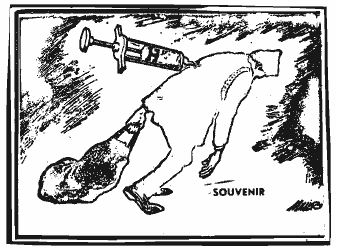 |
Cartoon by Miller in the G.I. paper Forward, 1974 |
WATCH LISTS AND RED SQUADS
The CIA, FBI, and military intelligence were not the only conspirators in the manipulation of underground writing. The Special Services Staff and the Intelligence Division of the Internal Revenue Serviceused their powers to audit tax returns and collect confidential information to harass and spy on allegedly dangerous writers. The Special Services Staff Director, for example, asked the Detroit District Office of the IRS to investigate the Radical Education Project as part of the IRS's participation in "an effort to save the country from dissidents and extremists."24 At the request of the CIA, the IRS audited Victor Marchetti in 1972, while hewas writing a critique of the CIA. It investigated Ramparts magazine in 1967, following its publication of an article detailing CIA connections with the National Student Association.25 Not only useful to the CIA, the IRS also served the Nixon administration as an instrument to stifle dissent. In a 1970 memorandum, a Nixon aide stated: "What we cannot do in a court room via criminal prosecutions to curtail the activities of some of these groups, IRS could do by administrative action. "26
The National Security Agency, with a high-tech electronic spying apparatus and a "watch list" (compiled with the help of the CIA, FBI, Secret Service, and the Bureau of Narcotics and Dangerous Drugs27) had the power to monitor the communications of over 75,000 Americans. The data they gathered illegally went into a vast information storage system, for purposes of future control of free speech.
In 1956, local and state police formed their own intelligence network, the Law Enforcement Intelligence Unit (LEIU), independent of federal control. The LEIU hounded groups and individuals it branded "terrorist." A computerized Interstate Organized Crime Index was established by the LEIU to provide a central data bank for the program. In addition to supplying surveillance equipment, the CIA trained the LEIU's intelligence units, or Red Squads, in covert intelligence techniques, maintaining a liaison with the LEIU through the Fairfax County, Virginia, Police Department.28 The FBI worked hand in glove with most police departments. Through them, it helped create several paramilitary vigilante groups that engaged in violent attacks on underground publishers. In addition, the 113th Military Intelligence Group provided money and arms for the Chicago Red Squad, which in turn passed the money along to a paramilitary organization, the Legion of Justice. The Legion became known for its vicious assaults on people who worked at underground papers and bookstores, on New Left activists, as well as for its theft of legal files belonging to the Chicago Conspiracy Trial lawyers. This Law Enforcement Intelligence Unit operated almost entirely in secret, with no regulation of its criteria for surveillance, its methods or its use of information.29
Many covert and illegal activities were encouraged by Presidents Johnson and Nixon, whose administration pushed for an unprecedented control over its critics. In addition to coordinating federal law enforcement and intelligence agendes, the Nixon administration moved to exploit the subpoena power of grand juries. The First Amendment rights of underground writing as free political and artistic expression were ignored.
While alternative media were only one aspect of a general social, political, and cultural movement, their importance to a pluralistic counterculture was not lost on entrenched interests. In time, the network of government control was to touch every writer, editor, publisher, printer, and distributor of underground writing. A coast-to-coast juggernaut was mobilized to keep tabs on every American who could be labeled "extremist," "communist," "socialist," "dissident," or sometimes even "liberal." Most small, independent underground publications could not withstand the pressures applied by the various agents of government.
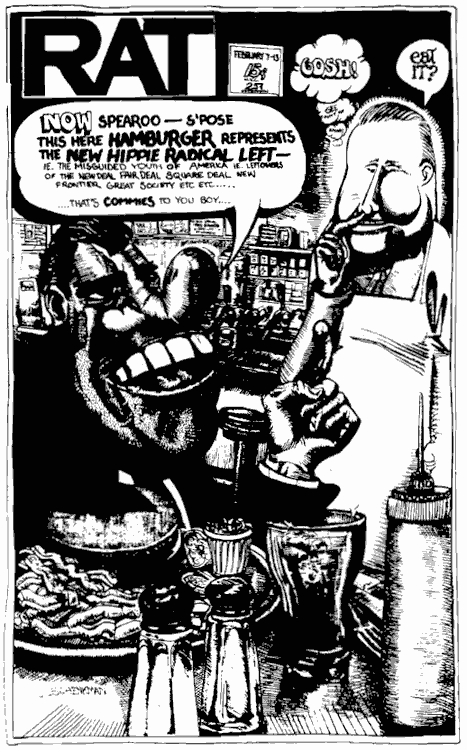 |
A HISTORY OF HARASSMENT
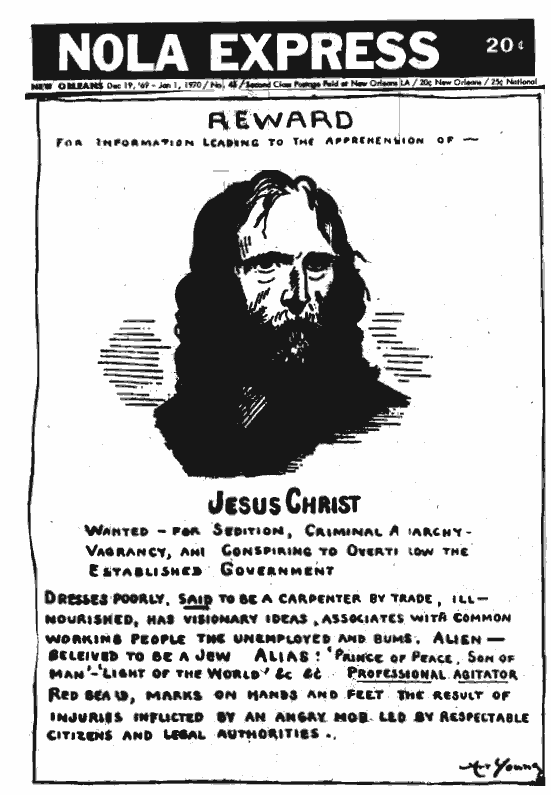
NOLA Express, December 19-January 1, 1970 (cover by Art Young).
Outside of large cities, underground publications were often the sole source of avant-garde literature, progressive news, and political information. Massive anti-war demonstrations, college campus unrest, experimentation with foreign religions and drugs, and an attitude of contempt for conventional national goals provoked a kind of hysterical reaction in many communities. At the same time, the alternative media took moral stands against war, violence, imperialism, racism, and the nuclear menace. Exuberant and provocative, it engaged in a kind of muckraking of business and political corruption—in the tradition of Lincoln Steffens, Ida Tarbell, and Upton Sinclair. The appalling horrors of the Vietnam War inspired scathing political invective. Many papers made liberal use of ribald satire and profanity. Others extolled drug use, sexual liberty, and theatrical politics in ways that were objectionable not only to conservatives, but also to some people in the Movement. To local authorities, underground newspapers seemed to be the focal points for an emerging social revolution that had to be stopped.
According to the Underground Press Syndicate, there were, in 1971, over 400 underground publications in this country.30 By 1978, there were only 65, and more than a third of these had been founded after 1973.31 This extraordinary rate of attrition was largely due to the pitched battle for survival these journals were forced to fight. The UPS reported that sixty per cent of its members had experienced a great deal of government interference,32 ranging from distribution interruption, customer and printer harassment, to wiretaps, legal costs, infiltration by agents, and even bombings and bomb threats.
By using narcotics and obscenity statutes as a pretext, police found it easy to attack the new media on grounds which reflected a traditional, puritanical morality distinct from any notion of political rights. This strategy of oblique attack made an effective, if meretricious, appeal to people already uneasy about growing family and community instability, not to speak of terrifying developments in world affairs. While the thrust of much underground writing was to demonstrate the inextricable links between moral and political notions, government agencies sought to efface these larger issues with the imposition of arrests on phony charges and the sheer expense of legal fees, which effectively silenced many papers not cowed by physical abuse.
STREET CORNER JUSTICE
The FBI often used intimidation against distributors as well as journals: simple persuasion worked from time to time, as when the FBI convinced a New York shipper for the Black Panther Party Paper to make his rates prohibitive.35 After a visit by FBI agents, the distributor of the New York-based Rat refused to continue doing business with the paper.36 In their vendetta against Rat, the FBI, according to a postal worker, ran a "cover" on the paper's mail, spying on all correspondence the editorial board received. The FBI documents also reveal that the Bureau owned subscription lists of the East Village Other and the Yipster Times and interviewed many of the subscribers.37
When twelve vendors from NOLA Express in New Orleans were arrested in a three-month period in 1969, the editors obtained an injunction against further arrests. The paper was banned from college campuses in the area. College authorities across the country banned the campus distribution of much underground journalism: in both Austin, Texas, and Madison, Wisconsin, papers like The Rag and Kaleidoscope were forbidden on campus. It took a three-judge federal panel to find this ban unconstitutional, ruling, "First Amendment freedoms are not dependent upon the will of an administrator."38
LOVE NOT WAR
Obscenity laws gave the police a tool that appealed to citizens disturbed by turbulent changes in the sexual mores of a large youthful population. While underground papers were describing napalming, bombing and defoliation in Vietnam and Cambodia as government-sponsored obscenities, police agents were prosecuting alternative journalists for printing four-letter words, "lewd" pictures, or depicting people making love. When the underground press transgressed conventional ideas of public decency, the government exploited the possibilities of clouding the issue of free expression.
Miami, Florida, was the scene of a nefarious campaign against The Daily Planet. Its editor was arrested twenty nine times in 1969 and 1970 for selling obscene literature on the streets. Although he was acquitted twenty-eight times, he still had to pay nearly $93,000 in bail bonds.39 When Allen Ginsberg came to Miami to give a benefit reading for The Daily Planet, the police broke up his reading of "Pentagon Exorcism." It took an appeal to the federal courts to prove that the reading was, in fact, constitutionally protected. The court ordered city officials to give The Daily Planet the municipal auditorium to complete the interrupted reading of his poem.
In March, 1969, Open City in Los Angeles was forced to pay court costs and a $1,000 fine on an obscenity conviction.40 This paper was later vindicated by a higher court, but the punitive defense fees forced Open City out of business. The street vendors of Kaleidoscope in Madison, Wisconsin, were repeatedly arrested for selling obscene literature to minors.41 As reported in the New York Times, this was only part of a campaign that included the publisher's arrest for obscenity, an editor's arrest for refusing to reveal sources, and the firebombing of the offices of the paper and an editor's car.
NOLA Express: A PYRRHIC VICTORY
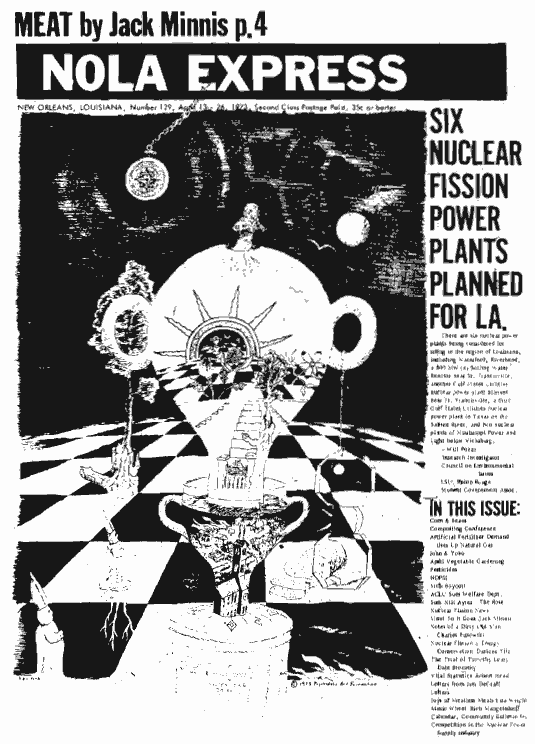
NOLA Express, April 13-26, 1973 (cover co 1973 Psychedelic Art Foundation)
NOLA Express was an important political voice in New Orleans. The paper specialized in the ecological examination of the local terrain and in criticism of local nuclear power initiatives. Like many other counterculture papers of the period, NOLA Express linked artistic and political strategies, publishing avant-garde poetry and fiction, with writers like Charles Bukowski and William Burroughs. While NOLA Express was engaged in the publication of new literary and political ideas, the FBI was busy keeping track of NOLA Express. Documents released in 1979 under the Freedom of Information Act prove that the paper was under continuous surveillance by the FBI. FBI files contain testimony from confidential informers about printers, distributors, writers, and the political affiliations of staff members. John Sinclair, an important activist in the White Panther Party, was, among many other contributors to NOLA Express, a target for FBI surveillance. NOLA Express was forced to suspend publication in 1974 because it was evicted from its office and was putting money into a court case against a proposed nuclear power plant. Even after the demise of the paper, the FBI followed the staff. An FBI memorandum of January 21, 1976, noted that NOLA Express editors were back in New Orleans to find a printer for a new publication, Evolution and Energy.44
 |
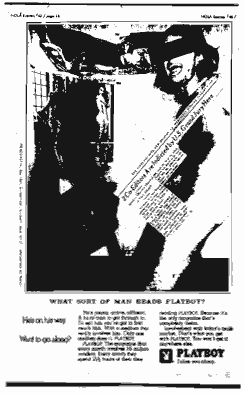 |
|
|
NOLA, like other papers with adversary political |
"Ad" satirizing Playboy taken to court. |
In 1969, NOLA Express and Logos, another New Orleans underground paper, won an injunction against the arrest of vendors, but within months a NOLA Express vendor was
NOLA, like other papers with adversary political content, was harassed for printing the same advertisements that ran in establishment media.arrested for "failure to move on." A United States District Court found the arresting officer in contempt of the injunction.
The history of NOLA Express was punctuated by government interference. An important case brought against the paper in 1969 attempted to prove that NOLA Express was mailing obscene material. The Federal District Court dismissed the charges on First Amendment grounds. The Court said that the item provoking the charges—a photograph of a nude man masturbating above a caption reading, "What sort of man reads Playboy?"—was designed to ridicule rather than incite prurient interest. The Court further ruled that a publication is obscene only if the entire work is sexually explicit material:
... It is newsprint, evidently intended for social commentary ... It represents a relatively new medium of political and social discussion in this country, sometimes called the underground press. In their newspaper, defendants urge a radical departure from the generally accepted way of life, and they use new and radical means of expressing their point of view. Judge Clark's conclusion with regard to the banning of Lady Chatterley from the mails is directly applicable here:"In short, all these passages to which the (United States Attorney) takes exception-in bulk only a portion of the book-are subordinate, but highly useful, elements to the development of the author's central purpose. And that is not prurient."For these reasons I hold that the material that defendants are charged with mailing was constitutionally protected . . .45
Although the case established an important legal precedent for the distribution rights of underground newspapers, the trial produced unfortunate side-effects: the paper was forced to censor itself in order not to jeopardize ongoing litigation.
POLICE OBSCENITY
Hoping to eliminate the alternative media, the city of Milwaukee passed a tough, new obscenity law. It was immediately used to arrest John Kois, the editor of Kaleidoscope. He was fined $2,000 and given two years probation.46 Probation was an indirect means of censorship because the writer or editor became liable for any printed material that the court might construe as a probation violation.
A Milwaukee COINTELPRO memo of 2/14/69 outlines how the FBI suggested exposing two teachers at the University of Wisconsin, Milwaukee, for writing articles in a paper which the agency called "extremely pornographic in nature." The FBI proposed arousing public outrage for "permitting instructors at that school to engage in this type of activity."47 The editor, publisher, and cartoonist at the University of Hartford Liberated Press were all arrested for violating a Connecticut obscenity statute after they published a caricature of Nixon as a large, erect index finger.48
Police often used charges of pornography or obscenity to dismantle an entire publishing operation. In Dallas, the vice squad raided the office of Dallas Notes twice in the fall of 1968. The publisher was arrested, and two editors were intimidated into quitting. Armed with search warrants for "pornography," the police confiscated typewriters, cameras, darkroom and graphic equipment, business records, a desk, a drafting table, and all the copy for the next issue.49 The police never had to demonstrate how a drafting table could be considered "pornographic."
SABOTAGE OF NEWS SERVICES
The FBI and its allies also concentrated on underground news services. COINTELPRO documents reveal that the FBI constantly spied on the Underground Press Syndicate and the Liberation News Service, which sent information bulletins and news stories with a radical perspective to subscribing journals. The FBI directed the IRS to investigate the tax records of Liberation News Service. In a typical FBI "dirty trick," its New York office in 1968 tried to interfere in a leadership dispute in the Liberation News Service by sending anonymous letters to New Left and other progressive political organizations impugning the motives of the LNS factions. The FBI document on this plan contains an apology to the Director because the forged letters were "written in the jargon of the New Left, necessitating the use of a certain amount of profanity."50
The Alternative Press Syndicate (formerly the Underground Press Syndicate), an underground information and advertising clearing-house, was another victim of government suppression. It helped establish new papers, organized the defense of member papers against government action, and maintained an extensive library of underground literature. In 1969, UPS served a combined readership of twenty million. Cindy Ornstein and the late Thomas Forcade, Project Coordinator for UPS, were under constant surveillance. They were arrested while covering the 1972 Miami convention.51 In 1969, the Phoenix office of UPS, run by Forcade and Orpheus magazine, was infiltrated by a narcotics agent, who worked on the staff for six months. After he quit, local police raided the office with a warrant for illegal drugs. A thorough search, however, failed to turn up any drugs. In the course of the search, the police stole UPS subscription lists, destroyed files, and damaged the UPS library. Among the destroyed files were the legal records from underground papers which were being given legal aid by the UPS. When Forcade and UPS moved to New York, they continued to be harassed by FBI agents.52 On one occasion, Cindy Ornstein was arrested for violating a firearms act, and UPS material was confiscated in the process.
INTIMIDATION OF PRINTERS
Many underground newspapers had difficulty finding a willing printer. Local political pressure, the threat of boycotts by advertisers and customers, and the printer's own political orientation often resulted in a refusal to do business with underground newspapers. In some cases, printers' unions dictated that members could not handle the work of underground publications. There is evidence that the FBI was behind some of these obstructions. Orpheus was refused by thirty printers; the East Village Other and Rat were turned down by countless printers on the East Coast. A New Jersey printer who originally had an agreement with Rat later reneged after the state's Attorney General threatened prosecution for obscenity.53 Some papers were forced to cross state lines to find a printer. A printer agreed to accept the Seattle Helix only if the work was done secretly. After a visit from the FBI, the regular printer of the Los Angeles Free Press refused to continue. The Rag was turned down by several print shops in Austin. One printer who did accept its business delivered an issue with blank pages and black boxes masking sections he thought were obscene. COINTELPRO documents later revealed that at least one of The Rag's printers was persuaded to stop printing the paper after a visit by San Antonio FBI agents.54 A memorandum of October 13, 1970, from the Detroit FBI office proposed "the disruption of the physical plant of the Radical Education Project," a publisher of New Left documents.55
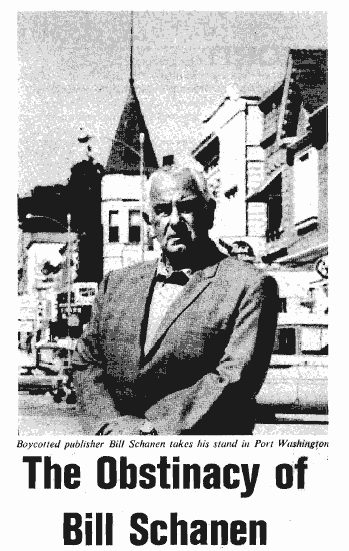 |
Life recognized the courageous stand for First Amendment rights taken by Wisconsin businessman Bill Schanen. "Kaleidoscope has merit," he said. "I don't agree with a lot of it but what are,we supposed to do, get rid of everything we don't agree with? There is an issue here that is much larger than Bill Schanen." |
In Port Washington, Wisconsin, William F. Schanen, Jr., of the Ozaukee Press took on the publication of dozens of midwestern underground newspapers, refusing to comply with FBI and local advertiser demands that he keep away from allegedly subversive projects. He lost nearly $200,000 per year in printing business and advertising in his three establishment papers because he brought out Kaleidoscope and other alternative papers. A local industrialist and the American Legion retaliated by leading a boycott of Schanen's papers and of his advertisers. By 1970, Schanen was printing papers from as far off as Omaha, indicating the difficulty these papers had in securing printers.56
Not all printers were as resistant as Schanen to government pressure. In 1980, the Emergency Coalition to Defend Student Rights at Cleveland State University received declassified FBI documents exposing the complicity of a printer with the federal agency in spying on underground papers. The FBI memorandum reads, in part:
... furnished the following information: ... advised that his company will not publish any material containing obscene words or highly critical of the United States. [Name deleted] advised however, that apparently due to his contacts with schools, he gets numerous requests to publish "underground newspapers." He stated that the most recent such newspaper was [name deleted]. He advised that this newspaper is severely critical of the United States and the last edition thereof contains numerous obscene words. He stated that this paper is put out by an individual by the name of [name deleted][Name deleted] then read both the second and the first edition and found them both to be very critical of the United States and the second edition had a considerable amount of obscenity. He printed the second edition, but deleted the obscenity therein. He then told [name deleted] to go somewhere else to do the rest of his printing. He advised that on September 29, 1970, an individual by the name of [name deleted] of Columbus, Ohio, brought in a tabloid, the name of which he could not remember, all pasted up and ready for printing, which he wanted printed. This paper was etremely [sic] smutty and extremely critical of the United States. Therefore, he refused to print it ...
[Name deleted] advised that in the future, when such papers are brought in, he will make a proof copy thereof and furnish this to the FBI, along with the name and address of the individual furnishing it to him. He will not print such material, however. He advised that he will notify the FBI when such material is brought to him.
The FBI also approached advertisers and investigated progressives who provided financial backing for underground papers. The agency wrote spurious letters when it was convenient. In 1969, the Detroit FBI office sent a letter to local advertisers signed "Disgusted Taxpaper and Patron" objecting to the content of one paper. In December, 1970, the Mobile FBI office sent an anonymous letter to a university administrator and threatened to expose two instructors who were providing money for a student counterculture newspaper. This action was intended to make the journal "fold and cease publication," to "eliminate what voice the New Left has in the area."57 The two instructors were put on probation.
HOUSING INTERFERENCE
COINTELPRO memoranda also reveal that the FBI pressured landlords to evict journalist tenants. The Los Angeles FBI field office reported its measures to get two New Left papers evicted in 1968.58 The same year, in New York, the FBI persuaded the landlord of Rat to double the office rent, forcing the paper to move. In Austin, Texas, the city condemned whatever building The Rag rented for its office. Fearing condemnation, landlords refused to rent to the paper.59
DRUG ABUSE OR DRUG EXCUSE
Richard Nixon made the issue of drug abuse a cornerstone of his "law and order" program in 1969. Local politicians and police agencies saw it was politically expedient to use drug laws to silence underground newspapers. It was easy to focus on drug abuse because drugs were considered a political issue by many in the counterculture. There is no question that drugs were widespread in countercultural communities and among the staff members of underground publications. Movements for the legalization or decriminalization of marijuana grew out of early advocacy of this cause in the underground press. All this made it easier for police to obtain search warrants to raid alternative press offices. If no drugs were found in a raid, as was often the case, other material was confiscated or photographed. CIA, FBI, and military intelligence agents who had infiltrated underground papers, or groups who worked with them, informed narcotics squads when drugs were being used. Tom Forcade of the Underground Press Syndicate observed that the rate of arrest of underground journalists for drugs was one hundred times the general rate of narcotics arrests.60
Newspapers had good reason to fear infiltration by police agents. Staff morale was undermined by the anxiety and distrust bred by the chance that narcotics agents might be among them. Often people were arrested, then offered suspended sentences in exchange for information.
A state-of-siege atmosphere prevailed in many alternative newspaper offices. In 1968, the St. Louis Daily Flash printed a series of articles critical of police chief Walter Zinno An undercover police officer was assigned to infiltrate the Flash. A short time later the police agent arrested an editor, Pete Rothchild, for suspected possession of marijuana.61 The Ann Arbor Argus ceased publication in 1970 when the entire staff was arrested on charges of drug possession, following an editor's arrest on an obscenity charge. The two-year-old paper had a circulation of 15,000. The editors of Rat and the Minneapolis Free Press were arrested, the Free Press editor sentenced to five years in prison for the possession of marijuana. After being arrested twice on pornography charges, then convicted for inciting riot, Stoney Burns, art director and founder of Iconoclast, was sentenced in Dallas, in 1972, to ten years and one day in prison for the possession of less than one-tenth of an ounce of marijuana. The extra day in the sentence prevented eligibility for parole.62 Within a year, public protest freed editor Burns.
Perhaps the best known case in which drug laws were used to silence radical writing was that of John Sinclair and the Artists' Workshop in Detroit.63 Sinclair had helped found the Artists' Workshop in 1964.
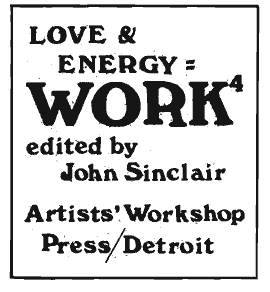 |
THE CREATION OF CONSPIRACY
The use of conspiracy and terrorist charges was part of an effective strategy to muzzle free speech. As in the Chicago Conspiracy Trial following the Democratic Convention of 1968, such charges were used to neutralize the influence of New Left and counter-culture leaders by embroiling them in lengthy and expensive trials. Nebulous conspiracy laws allowed prosecutors to harass dissidents by bringing vague charges before a grand jury, with the accusation almost always resulting in acquittal. As centers for counterculture and reform activity, underground publications were vulnerable to prosecution for conspiracy. New Left political activists—often editors and writers—were accused of directing alleged terrorist activity from news headquarters.
The Juche Cooperative of Cambridge, Massachusetts, was virtually destroyed by police agents acting illegally in a spurious search for terrorists. The Cooperative was the center for many self-supporting community activities, including a food cooperative, a clothing exchange, a bookstore, and a forum for poetry readings.It also produced Juche, an underground newspaper which reflected the grass-roots radicalism of the Co-op. On November 17, 1970, the center was raided by police; the next day the Boston Record American carried the headline: "'Revolutionary' Den Raided." The co-op members were charged with illegal possession of firearms and conspiracy to violate the firearms act. In fact, the weapons found in the center were legally registered and had been purchased for protection after repeated threats from right-wing vigilante groups. In the course of the raid, typewriters, books, subscription lists, and personal belongings were seized.64
INCITEMENT TO RIOT
Government paranoia 'in the wake of the bombing of Haiphong in 1972 resulted in a flurry of "incitement to riot" charges against underground journalists. Four writers from the Columbus Free Press were charged with causing the riot they covered. They were jailed for a week with total bail set at $100,000. It took a year before they were acquitted of the felony charge.65
Stoney Bums, editor of Dallas Notes, was charged with inciting a riot after his arrest in 1970 during a confrontation between young people and the police in a Dallas park. Shouting, "There's the one we want, right there," Dallas policemen grabbed Bums, clubbed him, and took him to jail. The riot charge was later changed to "interfering with an officer during a civil disturbance." Bums was convicted and sentenced to three years. This was not the first time Dallas police had clashed with the editor. In two earlier raids, police had confiscated Dallas Notes' property. Incoming mail addressed to staff members was often marked "Opened by mistake by U.S. Marshal's Office." Dallas Notes was banned on the Southern Methodist University campus, and students at North Texas State University in Denton were arrested for distributing an election issue. Before raiding Dallas Notes, police had Southwestern Bell Telephone disconnect the telephones. The paper's offices were twice attacked by organized vigilantes, who destroyed typewriters and printing equipment. At least three times shots were fired at Stoney Bums' car. Dallas police repeatedly stopped and searched automobiles owned by the workers. A Fort Worth man told Bums he had been hired to assault Bums physically. In view of the fact that Burns was later sentenced to ten years imprisonment for a minor drug offense, the charge of terrorist activity—inciting riot—proved to be just one of several tactics used to stop him and Dallas Notes. In filing suit on Bums' behalf, the Dallas Civil Liberties Union charged that"... the conduct on the part of the Dallas police is part of a conspiracy having as its object prohibiting the expression of ideas that are alien to the defendants, and having as its ultimate goal the abolition of Dallas Notes."66
The persistent persecution of Bums stemmed in part from Bums' 1967 investigative report in Dallas Notes about Texas Congressman Joe Pool's arrest for drunken driving, after his car hit a carload of soldiers at a red light. Pool was released and the arrest records destroyed after police realized who Pool was. The story did not appear in the big Dallas daily newspapers. In fact, the Dallas Morning News and Times Herald responded to the Dallas Notes report by reporting Pool's statement that the underground newspapers would "slander and libel everyone who opposes these traitors [the underground press] in their attempts to destroy American government."67 COINTELPRO documents petitioned by the Underground Press Syndicate reveal that Pool, a member of the House UnAmerican Activities Committee, called for an investigation of underground newspapers. These official records go on to state that Pool "has already made a major plank of his re-election campaign in Dallas the harassment of 'Notes from Underground' (Dallas Notes )."68
Articles exposing wrongdoing by political officials triggered attacks on underground newspapers in Philadelphia, including the use of terrorist charges against them. In 1968, after publishing several articles critical of the Philadelphia Police Department and its commissioner, Frank Rizzo, the Distant Drummer was charged by Rizzo with solicitation to commit murder. The District Attorney refused to prosecute, claiming that printing these articles did not constitute a crime.69 When the Philadelphia Free Press published damaging information about Rizzo and the police department, Rizzo vowed to destroy the Free Press just as he had the local Students for a Democratic Society (SDS) and the Student Nonviolent Coordinating Committee (SNCC). Between February and August, 1970, the Philadelphia Police Department assaulted one Free Press staff member, held several others in detention without charge, searched four staff members' homes without warrants, broke into their locked cars, confiscated political literature on narcotics warrants, and opened mail. At least six police cars at a time tailed Free Press staff members. In addition, police agents visited employers, advertisers, and the paper's printer. As a result, one staff member lost his outside job, the paper's printer refused to continue, and many advertisers withdrew their business.70 On July 28, 1970, the Philadelphia Evening Bulletin ran a major story on the Free Press, calling staff members "violent" and "hardcore revolutionaries." Material for the article came from Philadel phia police and FBI files and from Selective Service records. The story gave confidential financial, family, and employment information about people who worked for the Free Press and attempted to link them with Weather Underground bomb factories and the Cuban government.71 This portrayal of the Free Press as an advocate of violence and murder threatened to drive the paper out of business. More people were fired from their regular jobs, and because no new advertisers replaced those lost, the paper's free distribution was jeopardized.
In a hearing before the Senate Subcommittee on Internal Security in 1970—called to discuss "attacks" on local police by activists—Sen. Thomas Dodd announced his sponsorship of a bill that would "prohibit publication of periodicals that advocate violence against lawmen and overthrow of the Government." The Black Panther Party Paper and NOLA Express were cited as examples of violent publications. Sen. James Eastland introduced a similar bill, making it a federal offense to incite others to cross state lines to assault a police officer. Police from several states testified at the hearing, and endorsed the effort to prevent the circulation of the Black Panther paper.72
 |
|
MORE DIRTY TRICKS
Legal, financial, and psychological intimidation were common tactics, but it was very difficult to prove that the police had actually been acting illegally. Since the demise of many papers was due to trial expenses rather than actual convictions, the police could continue to harass writers and still keep their hands clean. However, when prosecutions proved unsuccessful, some agencies resorted to violent action. In communities where underground papers were a real political force, agents sometimes committed brutal assaults on papers and staffs. The larger and better-established underground newspapers seem to have received the brunt of the physical harassment possibly because they held up better under legal attacks than the smaller, more vulnerable journals.
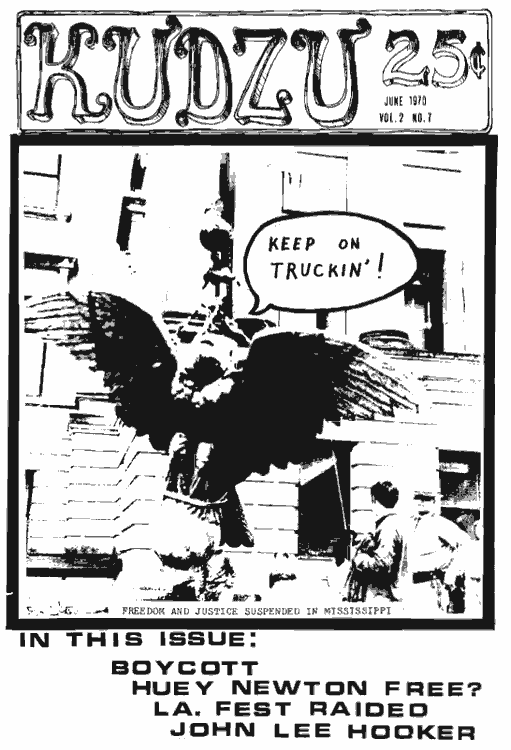
Kudzu, June, 1970
In many cases, violent acts were committed against underground newspapers while the people responsible for those acts were never identified. The fact that these acts of violence occurred in the midst of law enforcement actions against the same underground newspapers, however, cannot be overlooked. Police harassment of underground newspapers certainly encouraged groups intent on carrying out their own vendettas. These groups often assumed that their actions would either be condoned by the local police or, at the very least, that they would not be prosecuted. In fact, there were very few arrests made in connection with attacks on underground newspapers. When offices were firebombed, officials rarely intervened to protect the victims or to apprehend the perpetrators.

Space City, January 20-26,1972 (cover by Snell).
In most cases it was impossible to determine who planted
the bombs used against underground newspapers. The coordination
of bombings with authorized police campaigns
suggests they were carried out by police agents or groups
who knew officers would turn the other way. When the
offices of Orpheus in Phoenix were bombed unsuccessfully,
the police finished off the job, destroying UPS files. After
Atlanta's Great Speckled Bird won its obscenity trial in
1972, its offices were fire-bombed.
SECOND CITY AND THE "LEGION OF JUSTICE"

Second City, November, 1972
Then, in November and December 1969, Legion of Justice vigilantes attacked Socialist Workers Party headquarters in Chicago and Dekalb, destroying property, beating people, and stealing files. Second City was the only Chicago paper to publish a full account of the incidents. Therefore, it was not surprising that on February 3, 1970, four men from th~ Legion of Justice sprayed the Guild Bookstore with tear gas. They overturned bookshelves, threatened the bookstore attendant, and threw a dummy hand grenade as they fled. A few days later, a Second City street vendor was assaulted by three men, whom he later identified for the police. The police did not apprehend these men, members of the Legion of Justice. Instead they suggested the vendor come back the next day to swear out a complaint. That day, two of the thugs returned to the Guild bookstore, threatening an editor of Second City and another worker. When asked to get out, they burned a hole in the worker's jacket.
On March 11, five members of the Legion tried to disrupt a "war crimes tribunal" being held at a Chicago theatre. The Red Squad kept an eye on the proceedings until a few minutes before the arrival of a Legion gang, at which time the police unit retired to squad cars outside. When the thugs began breaking up the meeting, the officers refused to intervene with the excuse: "We aren't city cops—we're Red Squad."77 Participants in the tribunal, two of them from Second City, finally evicted the Legion members. Later, the police charged the tribunal participants with assault.
Police and vigilante coordination seemed routine. On March 13, eight Legion men converged on the Guild bookstore, threatening the lone attendant several times. When he held up a legally registered gun to protect himself, a dozen police officers appeared with guns drawn. The book clerk was arrested for aggravated assault and possession of an unregistered gun. The assault charge was later dropped. (The Legion failed to appear in court.) And the Guild employee was acquitted because the gun was legal. Whenever the Guild bookstore and Second City pressed charges for assaults by the Legion, the lattediled countercharges against its victims. On the two occasions when Legion members were convicted for their attacks on Second City, they were given minimal "good conduct" sentences and released. One of these terrorists was finally arraigned on major felony charges for the attack on the Socialist Workers Party.
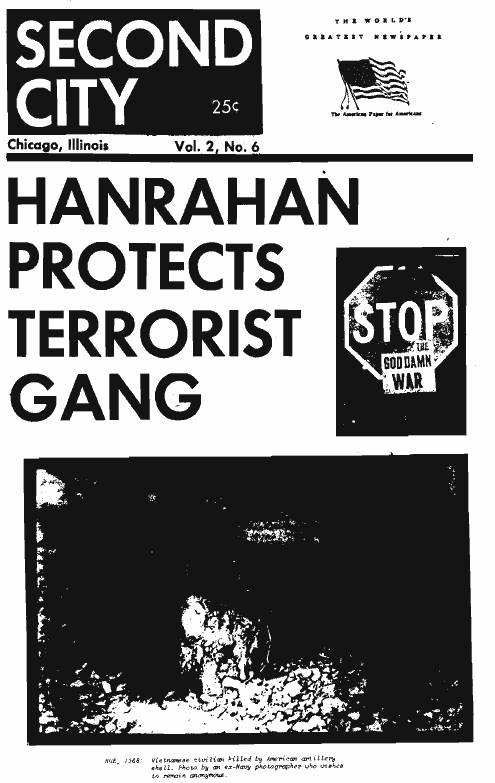
Second City No.6, 1970
Information released since 1970 reveals that the Chicago Police's Red Squad also worked in close cooperation with the Army's 113th Military Intelligence Group. The Red Squad's accomplices in the Legion of Justice received money, tear gas, mace, and electronic surveillance equipment from the 113th.78 Several times, material stolen in Legion burglaries found its way to the Military Intelligence Group.79 This included defense documents stolen from the attorneys in the Chicago Conspiracy trial. Army agents acted as observers in that burglary. Chicago police, in testimony before the Senate Committee on Intelligence, disclosed that a fire had destroyed Red Squad files, housed in police headquarters, during a probe of that intelligence unit.80 The CIA (through the Law Enforcement Intelligence Unit) also worked with the Chicago Red Squad and the Legion of Justice. The CIA and the Chicago Red Squad exchanged surveillance information through LEIU. In addition, the CIA trained spies for the LEIU. A CIA memorandum of February 8, 1973, listed some of the briefings and training seminars held for LEIU agents. Between October 6 and October 8, 1967, Chicago police participated in "demonstrations of explosive devices, an exhibit of foreign weaponry, air operations, and paramilitary displays ..." The CIA trained them in "surreptitious and nonsurreptitious entry" and in electronic surveillance. In several instances, the CIA provided the police departments with the equipment required for these operations.81
"... IN THE INTEREST OF JUSTICE"
The Milwaukee and Madison Kaleidoscope, which together had a circulation of 30,000, were the objects of violent attacks that seem related to simultaneous legal prosecution. An FBI COINTELPRO memorandum of February 14, 1969, proves that the Milwaukee Kaleidoscope was under FBI surveillance.82 While editor John Kois was on probation in the late 60s for his obscenity conviction, his car was bombed and shot at. The newspaper office also was bombed and its windows shattered by gunfire. Kaleidoscope, more than other alternative journals, seems to have been persecuted more for exercising normal press freedoms than for the content of the material printed. Photographer Gary Ballsieper was arrested four times for disorderly conduct while taking pictures for the journal. He and Kois were arrested in Chicago covering the antidraft trial of the Chicago 15. They were jailed with the defendants and temporarily charged with conspiring in their case.83
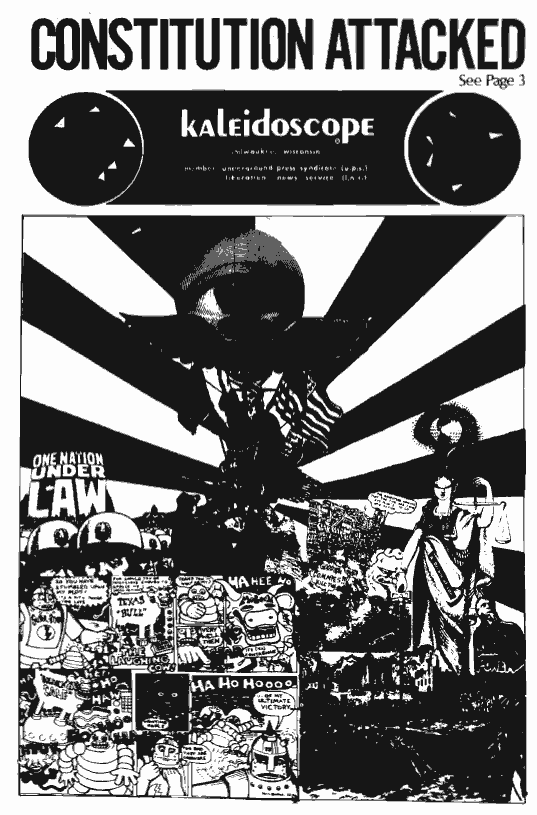
Kaleidoscope, July 26-August 8, 1968
The Kaleidoscope case shows how underground papers were forced to struggle for the simplest press rights. It was virtually impossible for critics of the government to get press passes to major events and press conferences. For several years Tom Forcade was the only underground reporter with press clearance for the House and Senate.
In some cases, the State tried to silence alternative journalism by arguing ownership of information. In 1970, the editor and a writer for the Los Angeles Free Press were convicted of receiving stolen property—that is, information—from the California Attorney General's office. This property consisted, in fact, of a xeroxed list of state narcotics agents that a government worker gave the Free Press. When the paper published the names and address of some of these agents, it was taken to court by the Attorney General and fined $10,000. Defense attorneys argued that information does not qualify as property, citing as precedent a case in which Drew Pearson had been acquitted for reporting "stolen" information about Senator Thomas Dodd. The court had ruled that the press cannot be limited to publishing only information about the government which the government itself issues.
This same issue has resurfaced in 1981, with government attempts to silence the Covert Action Information Bulletin, Philip Agee, and others who publish names of U.S. intelligence agents. The Agent Identities Protection Act, proposed in both houses of Congress, makes it a federal offense to publish classified or unclassified information which may be used to disclose intelligence operations or the identities of intelligence agents. Intelligence agencies would become the sole source of information about themselves.
In May, 1972, Ron Ridenour, of the Los Angeles Free Press, was arrested while covering an anti-war demonstration in front of CREEP (Committee to Re-elect the President) headquarters. Two police officers pushed Ron Kovic, a paraplegic Vietnam veteran, from his wheelchair and began to beat him. When Ridenour shot pictures of the incident, from fifteen feet away, the police confiscated his camera and arrested him for unlawful assembly and interfering with a police officer. He was convicted and sentenced to a year in jail. When his camera was returned, the film had been exposed.85
In 1971, Tom Miller, a freelance writer for the Underground Press Syndicate, Rolling Stone, and other journals, was subpoenaed by a federal grand jury to testify in its Tucson hearings on the Weather Underground. The Justice Department refused to allow Miller the exemption customarily allowed reporters because he was a freelance writer and an activist. Before this issue could be resolved, the original grand jury disbanded.86
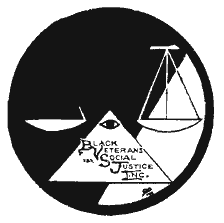 |
|
TARGET: PANTHERS
The U.S. government saw the Black Panther Party as the center of black liberation struggles in the country, and the FBI kept it under constant surveillance. It was a prime target of COINTELPRO operations; documents show that 233 of 295 authorized COINTELPRO actions against black groups were directed against the Panthers. Among the crimes committed by the government in dealing with the Party were spying, wiretaps, forged defamatory letters, disruptions of meetings, provocation of dissension, gang wars and, finally, murder.
Not only was the Black Panther Party destroyed by government agents, but underground papers were not allowed access to report the trial of Party members in New Haven in 1971. A group of writers formed an Ad Hoc Committee for a Public Trial to protest their being denied access to the trial by a "conspiracy"90 of the Nixon administration, the Federal Bureau of Investigation and the State of Connecticut.
Long after COINTELPRO authority had ended, the FBI carried on as usual. The Socialist Workers Party suit in 1976 revealed continuing wiretaps and burglaries.91 Recently released FBI documents show FBI surveillance of the Independent Eye of Cincinnati during July, 1975, just before the newspaper went under. Commenting on this recent disclosure, the agent now in charge of the Cincinnati FBI office stated that the Bureau could not investigate political groups "unless there is evidence of criminal conspiracy."92 The FBI has so often found criminal conspiracy where it does not exist, this statement is not reassuring.
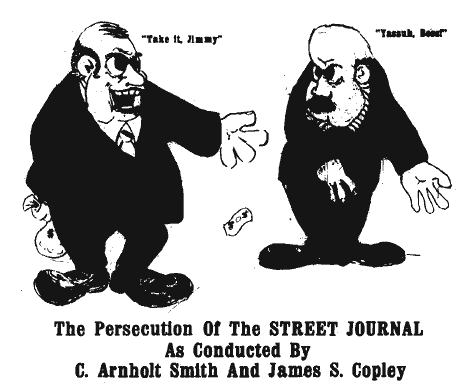 |
San Diego Street Journal, December 12-18, 1969 |
A classic example of government efforts to muzzle an underground newspaper is the case of the San Diego Free Press and Street Journal, founded in 1968 by The People's Commune. The commune also operated a retail store, Peoples' Dry Goods, which sold works by local artists and craftspeople, published handbooks and pamphlets, supplied office space to the Movement for a Democratic Military, and provided five-cent dinners for San Diego citizens in need. All this was going on in a community dominated by a large U.S. Navy presence, a strong John Birch Society, two daily papers owned by conservative James S. Copley, and a business community headed by financier D. Arnholdt Smith, a major fundraiser for Richard Nixon and Ronald Reagan. The Street Journal's troubles began after one of the first issues exposed the corrupt, Mafia-related deals of a prominent businessman, who was later imprisoned for his crimes.96 In October, 1969, the newspaper picked up a story reported in the Wall Street Journal (but unreported in the Copley papers) concerning the large profits made by D. Arnholdt Smith at the expense of other stockholders in transactions with public companies he directed. Smith was reported to have reacted to the Street Journal's story by saying, "I wish there was some way to bomb them clear to the other side of the Coronados."97 Soon afterward, the bombing began.
A suit filed by the Street Journal and the Peoples' Commune in 1970 against the San Diego Police Department, the City of San Diego, and officers of both lists attacks on the newspaper between November 1, 1969, and February 24, 1970.98 In a single month, twenty street vendors were arrested for "obstructing the sidewalk." Vendors of other publications, in the same locations, were not arrested. In December, 1969, a municipal court ruled the obstruction ordinance to be unconstitutional, but police continued to make arrests on the same charge. On November 18, 1969, bullets were shot through the windows of the paper's editorial offices. The incident was reported to the police, but they took no action on it. On November 23, five San Diego squad cars surrounded the offices of the paper and police searched the office twice without a warrant, arresting seven members of the Peoples' Commune on various charges. The charges were later dropped.
On November 29, 1960, the glass door to the Street Journal's editorial office was smashed and 2,500 copies of the current edition stolen. This occurred during the period San Diego police were keeping watch on the commune. When staff formally reported the incident, the police once again did not investigate. On December 1, the Street Journal's landlord received telephone calls demanding the paper's eviction. Throughout this period, commune members and other tenants of the building received bomb threats. The police were informed and did not investigate. The newspaper was forced to find new offices and reached an agreement with one Billy Joe Reeves. On December 14, a San Diego police officer asked Reeves to cancel the lease as "a personal favor." Reeves refused but he agreed two weeks later after being arrested on a murder charge. He was detained for an hour, and his offices were searched. Commune members later learned that the murder suspect being sought was five feet, eight inches tall, weighing 175 pounds, while Reeves was five feet, three inches tall, and weighed 114 pounds.
On December 11, 1969, two police officers, without a search warrant or consent, entered and searched the Street Journal and arrested a friend of the commune members on suspicion of burglary. The victim was handcuffed and taken away, then released without being booked. On December 25, hoodlums invaded the editorial offices, stole business and subscription records, and destroyed expensive typesetting equipment. The police were informed and did not investigate. On January 3, 1970, a car belonging to a Street Journal writer was fire-bombed. When informed, the police threatened to impound the car at the paper's expense if it were not removed from the street. On January 9, police impounded another automobile, owned by a commune member and legally parked, for remaining in the same location for seventy-two hours. The day before, a driver of that same car had received a ticket for a traffic violation in another part of San Diego. The next day a Street Journal staffer got a ticket for an invalid driver's license, even though he had, in fact, shown the officer a valid license. On January 15, 1970, six police officers and four United States Navy Shore Patrolmen entered the newspaper's premises without a search warrant or consent. They interrogated people from the commune, opened envelopes, files, and address books, copied information, confiscated personal property, and threatened physical violence if the victims attempted to communicate with a lawyer. On January 6 and 15, street sellers were arrested for violating nonexistent laws. On January 17, a commune member, just discharged from the Navy, was arrested for wearing a military jacket. He was held for fourteen hours and interrogated before charges were dropped. On January 18 and 25, three vendors were arrested for littering and held on $1,500 bail. On February 4, San Diego police and Shore Patrolmen again illegally searched newspaper offices and arrested staff members on phony charges, later dropped. On February 8, they attacked the Peoples' Commune again, threatening residents and searching the premises. They smashed in the door and seized and dragged one person outside, though he was never accused of wrongdoing. Throughout the period of harassment, police routinely confiscated coin-operated vending machines owned by the Street Journal and held them at the police department.
The Street Journal's suit ends with the charge: "During the latter part of 1969 and 1970 to date, plaintiffs are informed and believe and therefore allege that officers of the said San Diego Police Department have kept plaintiffs under almost constant surveillance, in violation of plaintiff's rights of privacy, and that, included in such surveillance have been the use of wire taps, hidden microphones, and infrared photography, and that said surveillance has been conducted without any warrants or orders of the courts, or any reasonable, legal or probable cause whatsoever."
Harassment did not end when the lawsuit was filed. The searches continued, automobile tires were slashed, and the windows of stores selling the paper were smashed. A federal grand jury was convened in an attempt to indict the Street Journal on charges of "criminal syndicalism," a law used to crush organization and publication by the Industrial Workers of the World in San Diego in 1919. The law had been declared unconstitutional in 1950.99 Finally, the pressure of constant surveillance and intimidation forced the Street Journal to close down. It took nearly a year for the suit filed by the paper to be heard, by which time most of the plaintiffs had moved, and the suit was dropped.
Having annihilated the Street Journal, the San Diego right-wing coalition then turned to the San Diego Door. When it followed the path of the Street Journal, it too was attacked. Cars were firebombed, and office windows shot out. On one occasion, arsonists set the newspaper's office on fire, destroying typesetting equipment and almost killing a staff member.100 During this period, the two established daily newspapers in San Diego made almost no mention of the attacks on underground papers.
On June 21, 1971, a movie theatre showing X-rated movies was bombed while two San Diego police officers were sitting in the audience. An investigation found William Francis Yakopek to be the bomber and a member of the Secret Army Organization (SAO), the militant wing of the Minutemen, a far-right paramilitary group. The investigation also exposed Howard Berry Godfrey as a leader of the SAO and an FBI informant. Subsequently, Godfrey was called on to testify before the Senate Select Committee on Intelligence concerning the relationships among the SAO, the FBI, and the San Diego Police Department (SDPD). Godfrey told how the FBI and SDPD organized, trained, and equipped the Minutemen and SAO. Godfrey said he instructed the SAO in guerrilla warfare, locksmithing, propaganda techniques, and security and intelligence procedures. He gave information to the FBI in exchange for funds for SAO activities. Godfrey admitted that his group was responsible for firing on the Street Journal offices, smashing the windows of a store selling the Street Journal and Door, and stealing 2,500 copies of the Journal. In collaboration with a San Diego police officer who had infiltrated the Street Journal staff, the SAO destroyed the typesetting equipment and stole the newspaper's records.101
Information released over the years provides a disturbing picture of a coordinated effort to silence the Street Journal and other underground publications.102 In San Diego, local business leaders, the city police force, the district attorney, the U.S. Navy, the FBI and a paramilitary group all conspired against the constitutional rights of the Free Press. Long before this conspiracy was brought to light, however, its object had been accomplished.
THE MILITARY CAMPAIGN
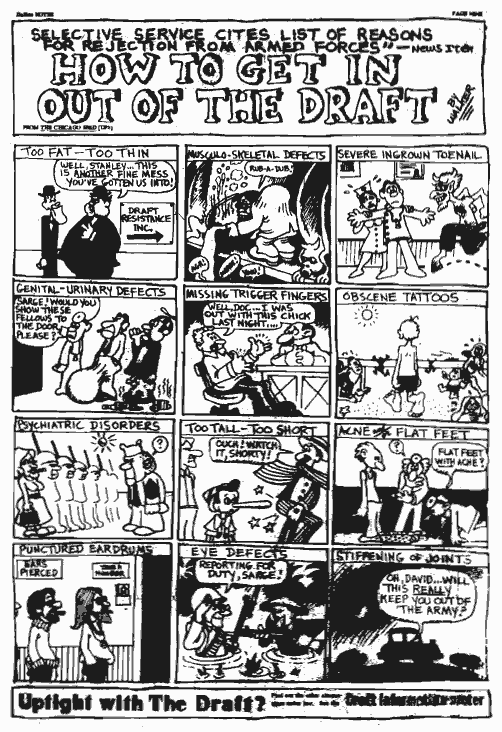 |
Dallas Notes, July 16, 1969 (cover by Walker). |
The war in Vietnam aroused opposition not only among civilian writers, but among members of the armed forces, who began their own underground papers. During the 1960s and 1970s, anti-militarism and anti-imperialism were forcefully expressed by the thousands of draftees pressed into fighting in Southeast Asia. Unable to tolerate dissent, military authorities worked relentlessly to drive military underground publications out of existence.
Given the great power granted the military command over its ranks, it is astonishing how many underground papers there were. The insulated nature of military life allowed military commanders to use their full authority to control the voice of dissent among servicemen. Intimidation by rank, the right to transfer, to demote, imprison and simply make life miserable were common tactics in the campaign against the freedom to write. Military authorities censored authorized military media so that GIs received only the information sanctioned from above. The issues at stake in the censorship of unauthorized military media were not only the right to receive and disseminate information, but the right of military personnel, as United States citizens, to express political opinions when not on duty. Censorship of the alternative newspapers clearly violated First Amendment rights of people in the armed services who wrote for and read those publications.
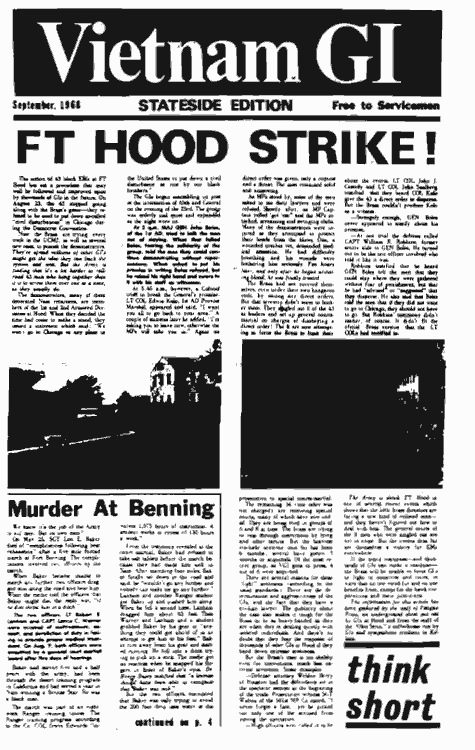
Vietnam GI, September, 1968
FUN, TRAVEL AND ADVENTURE
The first unauthorized newspaper of the Vietnam war era was The Bond: The Voice of the American Servicemen's Union, issued in 1967. This was followed by the newspapers Fun, Travel and Adventure at Fort Knox, Kentucky, and the Fatigue Press at Fort Hood, Texas.104 By 1970, the presses of sixty underground military newspapers were rolling. Generally written by GIs for GIs, they spoke out against the war in Vietnam. Many papers supported the American Servicemen's Union, which called for reforms in the military, including the election of officers by vote of the soldiers, racial equality, the right of free political association, and the right to disobey illegal orders.105 Articles outlined the rights of military personnel, described the process of obtaining conscientious- objector status, and documented the harassment of dissident GIs. Poems, short stories, and drawings by military personnel were often printed in these papers.
The regular apparatus for maintaining order and discipline gave the Armed Forces extraordinary powers of control in the campaign to silence military underground newspapers. GIs produced independent journals during their free time. Because they were printed on privately-owned equipment, they were outside the jurisdiction of the military command. So efforts to control the underground press had to be channeled through disciplinary structures of the armed forces that were established to prosecute breaches of military regimen and were not intended. to apply to off-duty activities. Military officials harassed individual soldiers by bringing disciplinary charges against them. In most cases these charges were entirely unrelated to the writing and publishing of dissident opinions, the offense for which the GIs were actually being punished.
The military police routinely confiscated shipments of military underground newspapers and harassed and arrested vendors. When dissident GIs were court-martialed for minor infractions of discipline, not only was their work with underground papers stopped, but their prosecution was intended to intimidate other GIs.
In August, 1969, for example, servicemen Henry Mills and John Lewis were stationed at Fort Dix, New Jersey, where they worked on the underground military newspaper SPD News. Both men were court-martialed on minor disciplinary charges. Mills was sentenced to six months imprisonment; John Lewis was fined for protesting Mills' arrest. Both men had to serve 76 days in the Fort Dix Stockade while awaiting trial.106
The military command also used its power to transfer staff members of underground papers. On January 25, 1970, an anti-war GI paper, Anchorage Troop was distributed near Fort Richardson and Elmendorf Air Force Base in Anchorage, Alaska. The following afternoon the military Office of Special Investigation (OSI) searched the editor's room without a warrant and seized copies of the newspaper, mimeograph material, and rough drafts of the next issue. The paper's editor, Ale George Edge, was then charged with violating Article 15 for an unmade bed, dirty floor, and improperly draped clothes. A court-martial was scheduled, but charges were dropped. Edge was at once reassigned to Kelly AFB in Texas and transferred there on less than twenty-four-hour notice. In this case, the efforts of the military command were thwarted, as Anchorage Troop stayed alive under another editor and Edge became the editor of Your Military Left in San Antonio, Texas.107
For the most part, the military used the same kinds of intimidation to silence dissent as it used to control other infractions of military discipline. In the case of underground publications, however, the Army went too far, harassing military personnel for actions the Defense Department had ruled to be consistent with military law. In September, 1969, the Department of the Anny issued its "Guidance on Dissent":
Dissent, in the literal sense of disagreement with policies of the government is a right of every citizen in our system of government; we do not ask that every citizen or every soldier agree with every policy of the government. Indeed, the First Amendment to the Constitution requires that he be permitted to believe what he will. Army regulations provide that personal literary efforts may not be pursued during duty hours or accomplished by the use of Army property. However, the publication of "underground newspapers" by soldiers off-post, and with their own money and equipment, is generally protected under the First Amendment's guarantees of freedom of the press. Unless such newspapers contain "language," the utterance of which is punishable under federal law (eg., USC Sec. 2387 or the Uniform Code of Military Justice), authors of an "underground newspaper" may not be disciplined for mere publication.1O8
A directive from the Assistant Secretary of Defense for Manpower followed, stating that military underground newspapers and demonstrations by personnel should be allowed, within limits, because "dissent in its proper sphere is healthy for the United States."109
The military command paid little attention. The large number of underground papers and dissident GIs active during the Vietnam war worried the Pentagon. According to the Church Committee report, military underground newspapers were a primary target of military intelligence, which usually tried to plant informants on paper staffs. In 1970, fourteen RITA (Resistance in the Army) groups were kept under watch. Those same years the Army monitored over fifty-three underground military newspapers.110
The Army's domestic intelligence program was exposed in 1971, and the public outcry forced the military to redefine the scope of its intelligence powers. The military argued that their abnormal powers came from the National Security Act of 1947, which gave to the branches of the service the responsibility of protecting the efficient functioning of those branches.111 Military intelligence was intended to protect the service from threats to its operation. The command decided the "efficient functioning" of the military was disrupted by opposition to U.S. and Pentagon policies. In response to accusations that there was no way to prevent illegal surveillance of civilians, the Defense Investigative Review Council (DIRC) was established in 1971 to look into all proposals for military spying on the home front.
Because no guidelines were ever established as to what constituted a threat, DIRC approval was virtually automatic. For example, in October, 1971, DIRC approved a request from Air Force Secretary John McLucas to investigate an underground paper published in the vicinity of Travis Air Force Base in California, in order to determine the danger it posed to Air Force activity and property.
The Air Force Office of Special Investigations spent an entire year trying, unsuccessfully, to plant a spy on the staff. In the end, it had identified fifty Air Force personnel and fifteen civilians who worked on the paper. The office did not report finding any evidence of threatening, subversive activity.112
AT HOME AND ABROAD
Military intelligence activity was not restricted to U.S.based military underground newspapers. In 1973, the Army attempted to infiltrate Fight Back printed in the university ambience of Heidelberg, West Germany. From 1972 through 1974, Army intelligence spied on the paper, Forward, published by civilians and service personnel in West Berlin. The Army placed informants on the staff and opened mail addressed to the newspaper. In Japan, the Naval Investigative Service monitored activities of underground military newspapers in Okinawa, Iwakuni, and Yokosuka. The Navy used a network of informants to get subscription lists and financial records of these papers.113
Despite harassment, several papers grew fairly large. Larger circulation invited even tighter surveillance by military authorities. Gigline, published in EI Paso, Texas, by GIs for Peace, was another victim of military disruption. The paper's cartoonist was transferred, without advance notice, from the United States to an infantry unit in West Germany. The editor was ordered to Vietnam on short notice. Courtmartial papers were drawn against a soldier who distributed Gigline on a post.114
The Ally, published in Berkeley, California, boasted a circulation of 50,000 among GIs stationed on the West Coast and in the Pacific. Distribution was continually under seige. When a soldier in Vietnam asked permission to distribute The Ally, he was transferred to a remote post. At this new post he asked again for permission to distribute the paper and received no answer. Three hundred copies of one issue sent to the soldier were opened in transit. When they did arrive, the soldier's platoon sergeant confiscated them. The GI finally distributed these copies but never received any of the subsequent issues mailed to him. A private at Fort Hood who distributed The Ally was court-martialed and sentenced to six months hard labor for distributing unauthorized publications. His sentence was then suspended, and he was discharged from the army as unsuitable for service. Another private arrested for distributing The Ally was court-martialed, fined, and shipped to Vietnam. Marine distributors of the paper at Iwakuni, Japan, were interrogated by the Criminal Investigation Division (CID) of military intelligence after receiving large shipments of The Ally. The marines, in turn, complained that their mail had been illegally opened. Their commanding officer held that the papers had been damaged in transit, and it was his duty to inspect any such damage. In Korea, the CID instructed mail clerks to impound shipments of The Ally. Many subscribers in Korea never received copies of the paper at all or received copies that had been opened and resealed.115
Unless an underground military newspaper had wide distribution, such as the one enjoyed by The Ally, control over the paper was usually in the hands of the local commanding officer. Occasionally, however, a campaign against a small paper betrayed evidence of collusion among military and outside government agencies. On July 1, 1970, military agents of the Office of Security and Investigations (OSI) used a warrant to search for marijuana in order to ransack the office of Broken Arrow. This was the newspaper of the American Servicemen's Union at Selfridge Air Force Base in Michigan. No marijuana was found, but the newspaper's files and the original copy for one issue were confiscated, along with a collection of civilian alternative newspapers, including The Guardian, Fifth Estate, and Seed. The newspapers were declared contraband, in violation of an Air Force regulation controlling handbills, posters, and similar written material. Two servicemen mentioned in the seized Broken Arrow were subsequently searched. Three months later, five civilian women were arrested for distributing issues of the newspaper on the base. The military police took them to the OSI, which delivered them to the local FBI. They were charged with trespassing on federal property.116
In most cases, punishment of military personnel was intended to intimidate other writers and publishers. Sentences were often suspended or replaced with transfers. The suspended sentence warned that disciplinary action was always possible for dissidents. Sometimes sentences were carried out, however, as in the case of SP 4 Harold Muskat of Fort Dix, N.J. On May 1, 1969, he was arrested for distributing The Bond, then sentenced to six months at hard labor, reduced in rank, and fined.117
CONGRESSIONAL DISSIDENTS BANNED
In 1970, the Secretary of the Army affirmed that military personnel had the right of access to unauthorized media, even if the distributor was a civilian. This followed a decision involving twelve civilians arrested for distributing The Bond and SPD News at Fort Dix. The court ruled that the civilians were on property open to civilians, and, therefore, they were not violating regulations.118 Around the same time, Joel Polin, an anti-war activist, had petitioned Fort Bragg,N.C., authorities for permission to distribute a reprint of the Congressional Record quoting Senators Eugene McCarthy, George McGovern, and Vance Hartke on the Vietnam war. When Fort Bragg authorities refused, Polin petitioned the Secretary of the Army, citing Army regulations: "A commander may not prevent distribution of a publication simply because he does not like its contents." After a year's delay, the Secretary of the Army agreed to permit Polin to distribute the leaflets, although he was allowed to do so for only one hour.119
THE CASE OF ROGER PRIEST
During the spring of 1969, the Navy took action against Journalist Seaman Apprentice Roger Priest. This action was significant because it indicated the military's willingness to openly restrict press freedoms when no other disciplinary avenues were available. Priest, assigned to the Office of Navy Information at the Pentagon, published the first issue of OM, The Servicemen's Newsletter on April 1, 1969. Within two hours of its appearance, Priest was reassigned to the Washington Navy Yard.120 One month later, after the second issue came out, Priest found himself under surveillance. The Navy assigned twenty-five intelligence officers to follow him and arranged with the Washington, D.C., sanitation department to have his garbage inspected.121 Priest made sure never to waver from the strictest interpretation of military regulations when performing his military duties. Hewas well aware of how minor infractions were used to silence dissent.
The case of Roger Priest was significant because the Armed Forces could not prosecute him on other than First Amendment grounds. Priest wrote, published, and distributed OM entirely on his own time, using privately owned facilities. Several times the Navy attempted to entrap Priest by having seamen ask him for copies of the paper while he was on duty, forcing him to violate base regulations.125 Priest always refused. Because Priest's publishing activities were not related to his military duty, his lawyers argued that charges be dismissed, citing a Supreme Court ruling prohibiting courts-martial for activities that were not service connected.
At the original hearing, the trial judges dismissed the charges of soliciting sedition and desertion. These charges were reinstated, however, on the order of higher Navy authorities. Apparently, because of Mendel Rivers, the military was willing to defy Defense Department directives and the Constitution in open denial of press freedoms to military personnel. 126 The Roger Priest case is evidence that the freedom guaranteed to military personnel by the Constitution and supported by Defense Department directives is often arbitrarily violated by military authorities.
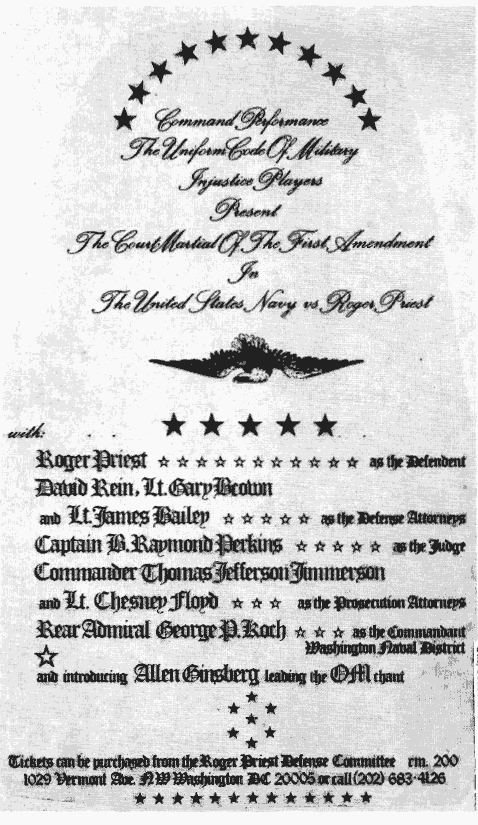 |
OM, Souvenir Court Martial Edition, 1969 |
INTO THE EIGHTIES
In 1969, Tom Forcade of the Underground Press Syndicate predicted that soon there would be "a daily underground paper in every city and a weekly in every town."127 Although that optimism proved unfounded, a few underground newspapers are still going strong. The Underground Press Syndicate is now the Alternative Press Syndicate, a clearinghouse and advocate for many remaining papers and publisher of Alternative Media magazine. Most surviving publications are aligned with particular liberation movements and are still under siege. Shipments of Akwesasne Notes, for example, a paper of the Iroquois Nation in upstate New York, were temporarily blocked by state and federal agents. Full-scale harassment of the Socialist Workers Party, the American Indian movement, the women's movement, and the anti-nuclear movement indicated that intelligence operations have not been curtailed. Out of the Department of Energy came the Federal Response Plan for Peacetime Nuclear Emergencies, giving the FBI authority over those who might pose a threat to nuclear developments. This has been in effect for several years. 128
In 1978, the People's Voice, a Dallas community paper, began covering an anti-nuclear coalition's efforts to stop nuclear power implementation in Texas. Freedom of Information Act documents reveal that not only the Armadillo Coalition but the People's Voice and its publisher (the community organization Bois D'Arc Patriots) were under surveillance by the Dallas FBI office and the Bureau of Alcohol, Tobacco and Firearms (BATF). A BATF memo dated November 27, 1978, reports that a People's Voice editor and reporter met with the Dallas BATF group supervisor in response to rumors that they were under investigation. The editor disclaimed any connection with an "anti-nuclear power" activist she knew was under investigation and with other activities under the bureau's jurisdiction. The memo—one of a series documenting investigation of the Bois D'Arc Patriots—goes on to report that the the reporter was told "that BATF is not performing such investigations and does not investigate groups or persons because of group membership. [Reporter's name blacked out] said that he assumed that BATF was conducting a tax investigation. He was told that BATF investigates violations of the gun control act, explosives laws and illegal liquor. He appeared not to believe. In summary, neither newsman (sic) was told the substance of our investigation and all questions were answered in general terms."129
On June 8, 1979, a memorandum from the FBI Director lists jurisdictional reasons the Dallas FBI office should join the BATF investigation, citing sections of the Atomic Energy Act. It also indicates that the Deputy Attorney General for Emergency Programs, the Secret Service, the Department of Energy and the Nuclear Regulatory Commission should receive data gathered in the investigation.130
In addition, the FBI and BATF are working with private energy corporations to stifle anti-nuclear dissent. A May 21, 1979, BATF memorandum on the investigation of the Armadillo Coalition reports: "On May 21, 1979, a meeting was held at the offices of Texas Utilities Generating Company, 2001 Bryan Tower, Dallas, Texas. The following officers of that organization attended the meeting, along with Special Agents [blacked out] These officers were advised of the status of this investigation and told what our needs would be as far as protection of the Comanche Peak Steam Electric Station on June 10th was concerned. They again said that the entire resources of their company would be at ATF's disposal ..."131 Following the 1980 elections, the government appears to be moving to legitimize and expand the old powers of the intelligence agencies. On April 15, 1981, President Reagan pardoned former FBI officials W. Mark Felt and Edward S. Miller after their conviction for authorizing illegal break-ins in 1972 and 1973. Reagan commended their work against dissident groups, saying they helped "bring an end to the terrorism that was threatening our nation."132 Because each Presidential administration rewrites history to accommodate its immediate interests, the characterization of dissent of the early 1970s as terrorist signals that dissidents will face serious harassment again.
On March 9, 1981, the ghost of COINTELPRO appeared in reports of proposed revisions in Executive Order 12036, concerning intelligence. Among these revisions are those that return to the FBI almost all the powers it used to disrupt underground newspapers. Citizen recourse and Congressional oversight are all but eliminated, and the protection of civil liberties, mandated by the original Carter Executive Order and Congressional action, are compromised in the interest of the "acquisition of essential information," (Section 2-102). Section 2-201 gives the Attorney General the power to approve by category—rather than by individual case—a wide range of covert intelligence activity without the necessity of obtaining a warrant. This includes wire-tapping, physical searches, mail surveillance, physical surveillance, break-ins, covert participation in organizations, and the collection, storage and dissemination of information on individuals and organizations. A restriction on indirect participation in prohibited or illegal activities is eliminated.133
Action by the Reagan administration is being paralleled in both houses of Congress, where legislation and subcommittee hearings aim to remove restraints on intelligence agencies by restricting access to information about them. The Intelligence Identities Protection Act, killed in committee in 1980, was reintroduced in 1981. It calls for prosecuting of unclassified information about intelligence agencies if that information reveals the workings of an agency. The bill's specific target is the Covert Action Information Bulletin, which exercises its Constitutional right in disseminating unclassified information. While the bill sweeps wide in an effort to encompass all publication about intelligence activity, its proponents claim that it is intended to protect "mainstream" journalists while permitting the prosecution of dissident journals opposed to intelligence activities.134 Representative Henry Hyde expressed the view that such journals should not be "permitted to hide" behind the First Amendment.135
Representatives in both houses have also announced their intention to propose new charters for the FBI and CIA that would expand their powers. Advocates say a major component of any new charter must exempt intelligence agencies from the provisions of the Freedom of Information Act. On May 4, 1981, Attorney General William French Smith rescinded a requirement that agencies must show that disclosure of information under the Act would be "demonstrably harmful" in order to withhold it.136 Under the new policy, the Justice Department will defend all agency decisions to withhold information, thereby subverting the intent of the Act and encouraging noncompliance.
Congress is also setting up investigative subcommittees to search out possible links between domestic dissident activity and international terrorist organizations. While FBI Director William Webster was stating that there "was no real evidence" "of direct, deliberate Soviet domination or control or instigation of terrorist activity,"137 friendly witness Arnaud de Horchgrave testified in the first day of hearings by the Senate Subcommittee on Security and Terrorism that the Soviet Union was involved in "the manipulation of the Western media" and had a "covert rote in promoting the anti-nuclear lobby."138 In seconding this testimony, subcommittee chairman Sen. Jeremiah Denton sent a message that any dissident writing or activity could be interpreted as linked to the Soviet Union or to foreign terrorists, thereby justifying intelligence action. Private advisory groups with links to the Reagan administration have joined this latest round of naming names. An organization called Accuracy in Media, whose newsletter is edited by Reagan supporter Reed Irvine, has recommended an investigation of the Pacifica radio network and a cut-off of federal funding because it "provides a platform for communists. "139 A report by the conservative Heritage Foundation, authored by Security and Terrorism Subcommittee aide Samuel T. Francis, suggests that Mother Jones, a survivor of the underground newspaper movement of the 1960s, be targeted for investigation.140
On May 3, 1981, over 50,000 people marched on the Pentagon to protest U.S. military aid to EI Salvador. It was the largest demonstration of its kind since the Vietnam War. On May 4, Attorney General Smith announced his directive supporting the withholding of information requested under the Freedom of Information Act. Once again widespread popular dissent is being heard in the land. And the mechanisms to suppress that dissent are once again in place.
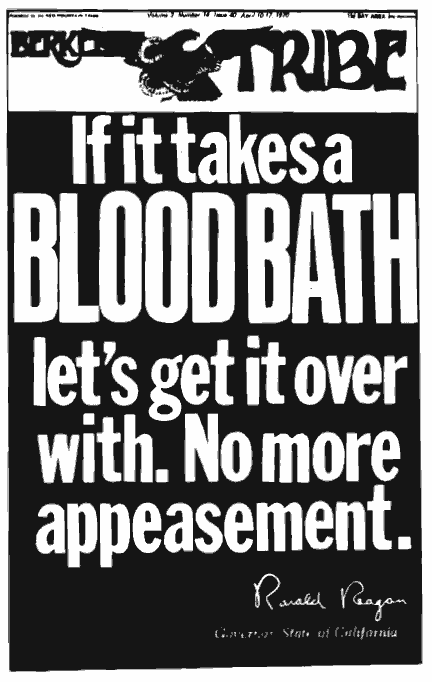 |
Berkeley Tribe, April 10-17, 1970 |
FOOTNOTES
1 John Burks, "The Underground Press," Rolling Stone, No. 43, Oct. 4, 1969, p.31.2 "Underground Fuck," San Francisco Express-Times, Dec. 11, 1968.
3 "Letter to Our Friends," Philadelphia Free Press, Aug. 2, 1970.
4 Rod Lord, "Letter: Dissent in the Service," Playboy, Nov., 1970.
5 Final Report of the Select Committee to Study Governmental Operations with Respect to Intelligence Activities, United States Senate, Supplementary Detailed Staff Reports of Intelligence Activities and Rights of Americans, Book III (Washington, D.C.: U.S. Government Printing Office, 1976), pp. 510-511.
6 U.S. Senate, Select Committee, Final Report, Op. Cit., p. 734.
7 Ibid., pp. 923-957.
8 Ibid., pp. 962-967.
9 Jerry J. Berman, Robert L. Borosage, Morton H. Halperin, Christine M. Marwick, The Lawless State (New York: Penguin Books, 1976), p. 120.
10 U.S. Senate, Select Committee, Final Report, Op. Cit., pp. 815-817.
11 Ibid., pp. 818-822.
12 Ibid., 823-824.
13 Letter from J. Edgar Hoover to Tolson, DeLoach, Rosen, Bishop, Sullivan, June 20, 1968. Expression Repression File: Freedom of Information Act Document, PEN American Center, pp. 194A-G. (Hereafter cited as FOIA [PEN].)
14 Berman, et aI., Op. Cit., p. 112.
15 Ibid., pp. 114-120.
16 Ibid., pp. 119-120.
17 Memorandum from the Director to SAC, Albany, July 5, 1968, FOIA (PEN), pp.40-42. .
18 Memorandum from the Director to SAC, Indianapolis, October 4, 1968; and memorandum from SAC, San Antonio, to the Director, January 17, 1969, FOIA (PEN), pp. 132A-C.
19 Berman, et aI., Op. Cit., pp. 140-141.
20 U.S. Senate, Select Committee, Final Report, Op. Cit., p. 681.
21 Berman et aI., 'Op. Cit., p. 32.
22 George O'Toole, "America's Secret Police Network," Penthouse, Dec., 1976 (Penthouse Ind. Ltd., New York, 1976).
23 John Marks, The Search for the Manchurian Candidate (New York: New York Times Book Co., 1979) pp. 120-121.
24 Berman et aI., Op. Cit., p. 200.
25 Ibid., p. 197.
26 Ibid., p: 200.
27 Ibid., p. 182.
28 O'Toole, Op. Cit.
29 Ibid.
30 Thomas King Forcade, "Obscenity, Who Really Cares?," Countdown, 1971, p.160.
31 "The Members," Alternative Media, Vol. 10, No.2, Fall, 1978, pp. 28-30.
32 John Burks, "The Underground Press," Rolling Stone, No. 43, October 4, 1969, p. 17.
33 Agis Salpukas, "Underground Papers are Thriving on Campuses and in Cities Across Nation," New York Times, April 5, 1970.
34 Memorandum from SAC, Newark, to the Director, June 3, 1970, FOIA (PEN), p. 65A.
35 Chip Berlet, "COINTELPRO," Alternative Media, Vol. 10, No.2, Fall, 1978, p.11.
36 Thomas King Forcade, "Free Media," (unpublished), 1970.
37 Berlet, Op. Cit., p. 10.
38 Newsletter for Intellectual Freedom, Vol. XIX, No.6, Nov., 1970, American Library Association, p. 90.
39 Agis Salpukas, Op. Cit.
40 Forcade, Countdown, p. 163.
41 Agis Salpukas, Op. Cit.
42 Forcade, Countdown, p. 171. (Unless otherwise noted, sources of information on individual publications can be found in the Expression Repression File, PEN American Center, listed under the name of the publication.)
43 Letter: Reber F. Boult, Jr.. ACLU Foundation, Southern Regional Office, Oct. 6, 1970. Expression Repression File: Great Speckled Bird.
44 FBI memoranda to and from SAC, New Orleans, April 16, 1969 through Jan. 21, 1976, FOIA (PEN), pp. 142-189.
45 USA vs. Robert Grady Head, Jr., et al., Criminal Action No. 32036, Section "C", United States District Court, Eastern District of La., New Orleans Division, Sept. 1, 1970.
46 Forcade,- Countdown, p. 166.
47 Berlet, Op. Cit., p. 12.
48 "Underground Fuck," Op. Cit.
49 Ibid.
50 Berlet, Op. Cit., p. 12.
51 SAC, New York, Report: "Underground Press Syndicate," Dec. 10, 1969. FOIA (PEN), pp. 300-307.
52 Forcade, Countdown, pp. 168-169.
53 Burks, Op. Cit., p. 31.
54 Berlet, Op. Cit., pp. 11-12.
55 Memorandum from SAC, Detroit, to the Director, Oct. 13, 1970, FOIA (PEN), pp. 65, 65A, 66.
56 John Pekkanen. "The Obstinacy of Bill Schanen," Life, 1970.
57 U.S. Senate, Select Committee, Final Report, Op. Cit., pp. 30-31.
58 Ibid.
59 "Underground Fuck," Op. Cit.
60 Forcade, Countdown, p. 169.
61 "Underground Fuck., Op. Cit.
62 Forcade, Countdown, p. 168.
63 Expression Repression File: John Sinclair, (PEN).
64 "Juche Collective Busted," Liberated Guardian, Dec. 14, 1970, pp. 16-18. "Pigs Freak Out," luche, November, 1970, p. 24. " 'Revolutionary' Den Raided," Record American, Boston, Nov. 18, 1970, pp. I, 3, 32.
65 Expression Repression File B-1: "Repression of the Underground Press" (unpublished ).
66 Doug Baker, Jr., "Why They Got Stoney Burns," Iconoclast, Dallas, Nov. 29, Dec. 6, Dec. 13, 1974.
67 Ibid.
68 FBI memorandum, Dec. 10, 1969, New York, FBI, FOIA (PEN), pp. 300-301.
69 "Underground Fuck," Op. Cit.
70 "Letter to Our Friends," Philadelphia Free Press, August 2, 1970.
71 Bayard Brunt and Albert V. Gaudiosi, "The New Revolutionaries: Head of Rebel Paper is Central Figure in New Left Here," Philadelphia Evening Bulletin, July 28, 1970, pp. AI, B3.
72 Paul Delaney, "Police Officials Endorse Senate Bills Aimed at Curbing Urban Guerrilla Warfare," New York Times, Oct. 7, 1970.
73 Hearings Before the Select Committee to Study Governmental Operations with Respect to Intelligence Activities, U.S. Senate, 94th Congress, First Session, Vol. 6, "Federal Bureau of Investigation," (Washington, D.C.: U.S. Government Printing Office, 1976), Exhibit 69-23, pp. 804-806.
74 Resist Newsletter #48, Dec. 2, 1970, p. 3.
75 "Repression of the Underground Press," File B-1.
76 U.S. Senate, Select Committee, Final Report, Op. Cit., p. 824.
77 Second City, Vol. 2, No.6, 1970.
78 O'Toole, Op. Cit.
79 U.S. Senate, Select Committee, Final Report, Op. Cit., p. 803.
80 O'Toole, Op. Cit.
81 CIA memorandum from Howard J. Osborn, Director of Security, to Deputy Director for Support, Feb. 8, 1973, FOIA (PEN), pp. 230-236.
82 Berlet, Op. Cit., p. 12.
83 Burks, Op. Cit., p. 30.
84 "Repression of the Underground Press," File B-1.
85 Ibid.
86 Ibid.
87 U.S. Senate, Select Committee, Final Report, Op. Cit., p. 30.
88 "Repression of the Underground Press," File B-1.
89 Dallas Morning News, Oct. 8, 1970.
90 New York Times, March 27, 1971.
91 Berman et aI., Op. Cit., p. 131.
92 Lew Moores, "FBI Opened Bank Records in Paper Probe," Cincinnati Post, March 22, 1979.
93 FBI memorandum from Washington, D.C., FBI to the Director, March 16, 1970, FOIA (PEN), p. 196F.
94 FBI memorandum from the Director to Washington, D.C., FBI, March 4, 1970, FOIA (PEN), p. 196B.
95 FBI memorandum from Washington, D.C., FBI to the Director, July 2, 1973, FOIA (PEN), p.196H.
96 Larry Remer, "Targets: Street Journal and Door," Alternative Media, Alternative Press Syndicate.
97 "Message from the Staff," San Diego Street Journal, July 24, 1970.
98 Lowell Bergman and Jan Diepersloot and the Peoples' Commune vs. O. J. Roed, et al., U.S. District Court, Southern District of California, Case No. 7057 S, Feb. 24, 1970.
99 "Message from the Staff." Op. Cit.
100 Larry Remer, Op. Cit.
101 Ibid.
102 Memoranda from SAC, San Diego, FOIA (PEN), pp. 190-193.
103 FBI memorandum from the Director to SAC, Chicago, May 3, 1968, FOIA (PEN), pp. 195A-195E.
104 Nanzy Beezley, College Press Service, University of Mo. Maneater, March 10, 1970.
105 The Bond, Vol. 3, No. I, New York, Jan. 21, 1969, p. 2.
106 Ibid., Vol. 3, No.8, Aug. 25, 1969, p. 3.
107 Your Military Left, Vol. I, No.8, San Antonio, Mar. 15, 1970, p. 11.
108 Stephen G. Gross, "Military News Media Censorship," Freedom of Information Center Report No. 243 (School of Journalism, University of Missouri at Columbia, June, 19701, p. 5.
109 The Repress, Vol. I, No.2, Washington, D.C., Dec. 1969, p. 4.
110 U.S. Senate, Select Committee, Final Report, Op. Cit., pp. 815-816.
111 Ibid., pp. 814-816.
112 Ibid., pp. 816-817.
113 Ibid., pp. 820-822.
114 Gross, Op. Cit., p. 6.
115 Rod Lord, "Letter: Dissent in the Service," Playboy, Nov., 1970.
116 "Air Force Cops Raid Union Paper," The Bond, July 22, 1970, p. 5.
117 The Bond, May 20, 1970, p. 3.
118 Ibid., April 22, 1970, p. 3.
119 "The Army Way," Playboy, Feb., 1971.
120 "Biographical Facts on Roger L. Priest," Priest Defense Committee (unpublished), Expression Repression File A-3.
121 Philip M. Stern, "Seaman Priest," The New Republic, Yol. 162, No.7, Issue 1877, Feb. 14, 1970.
122 Letter from L. Mendel Rivers to Rear Admiral Means Johnston, June 6, 1969, Expression Repression File A-3.
123 Letter from Rear Admiral Means Johnston to L. Mendel Rivers, June 20, 1969, Expression Repression File A-3.
124 Gross, Op. Cit., p. 7.
125 Alan Lewis, "First Amendment on Trial," Argus, Yol. 5, No.2, University of Maryland.
126 Stern, Op. Cit.
127 Burks, Op. Cit., p. 17.
128 Tim Butz, "Surveillance of the Anti-Nuke Movement," Public Eye, Yol. I, No.2, April, 1978, pp. 40-43.
129 BATF memorandum from Dallas groups supervisor to SAC, Dallas BATF district office, November 27, 1978, FOIA (PEN), p. PY-1.
130 FBI memorandum from the Director to Dallas FBI and San Antonio FBI, June 8, 1979, FOIA (Pen), p. PY-3.
131 BATF memorandum (No. 30060678 2502F) from Dallas groups supervisor to SAC, Dallas BATF district office, May 24, 1979, FOIA (PEN), p. PY-6.
132 Robert Pear, "President Pardons 2 Ex-FBI Officials in 1970's Break-ins," The New York Times, April 16, 1981, p. A-1.
133 Executive Order 12036, President Jimmy Carter, January 24, 1978; Federal Document 78-2420, filed 1-25-78, published in Federal Register, Yol. 43, No. 18, January 26, 1978. With suggested revisions added by Reagan Administration.
134 Charles Mohr, "Senate Panel Acts to Narrow Intelligence Identities Bill," The New York Times, Sept. 18, 1980, p. A-21.
135 Charles Mohr, "House Panel Clears Bill to Ban Naming of Covert Agents," The New York Times, Sept. 4, 1980.
136 Philip Taubman, "U.S. Agencies to Get Greater Discretion on Releasing Files," The New York Times, May 4, 1981, p. A-1.
137 Robert Pear, "FBI Director Sees No Evidence Soviet Fosters Terrorism in U.S.," The New York Times, April 27, 1981.
138 Charles Mohr, "Hearing on Terror Opens with Warning on Soviet," The New York Times,April 25, 1981, p. A-10.
139 "Look Who's Tapping the Federal Till," AIM Report, Accuracy in Media, Inc., Reed Irvine, ed., Yol. IX, No. 20, October 11, 1980.
140 George Larner, Jr., "Assault on Terrorism: Internal Security or Witch Hunt?" The Washington Post, April 20, 1981, p. A-1.
Back To History Is A Weapon's Front Page






